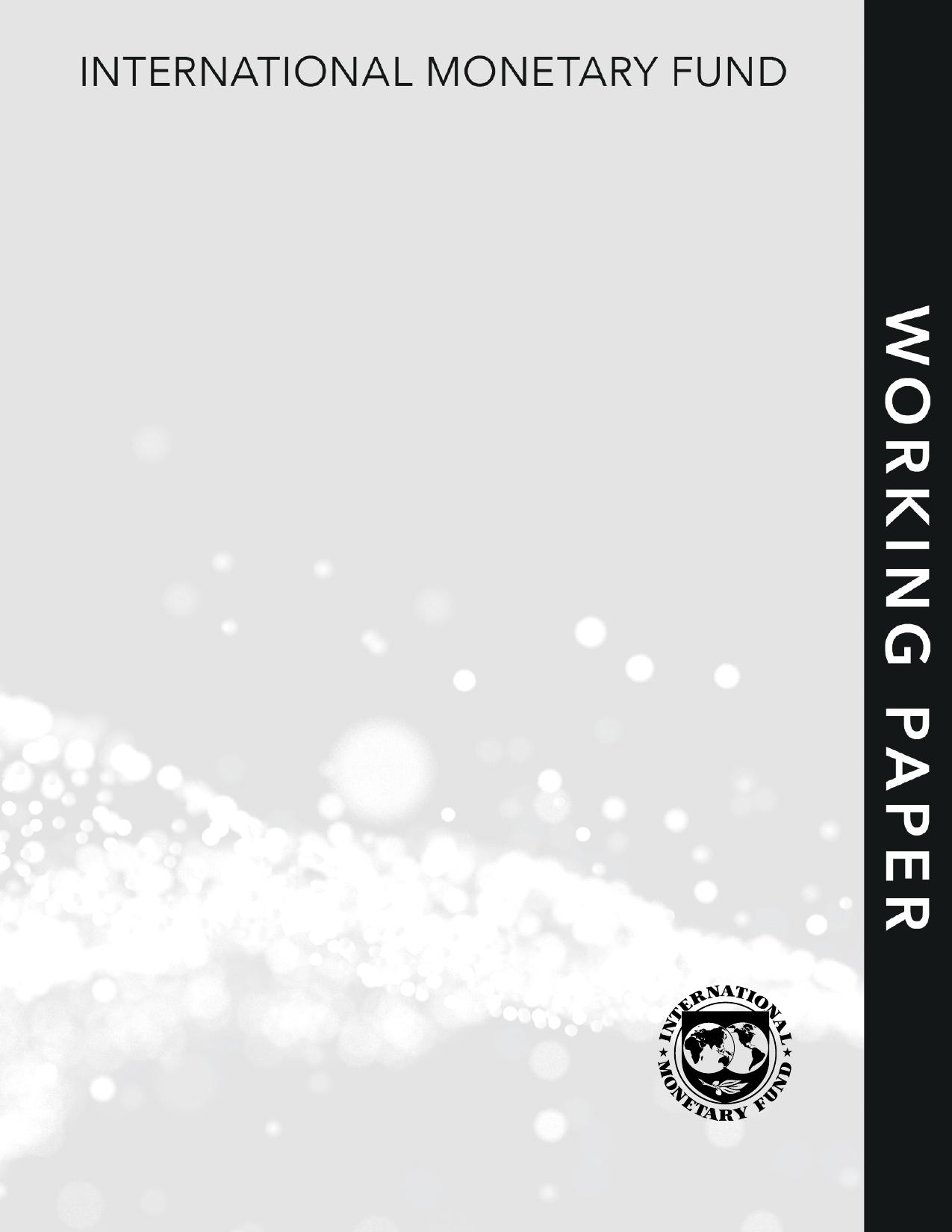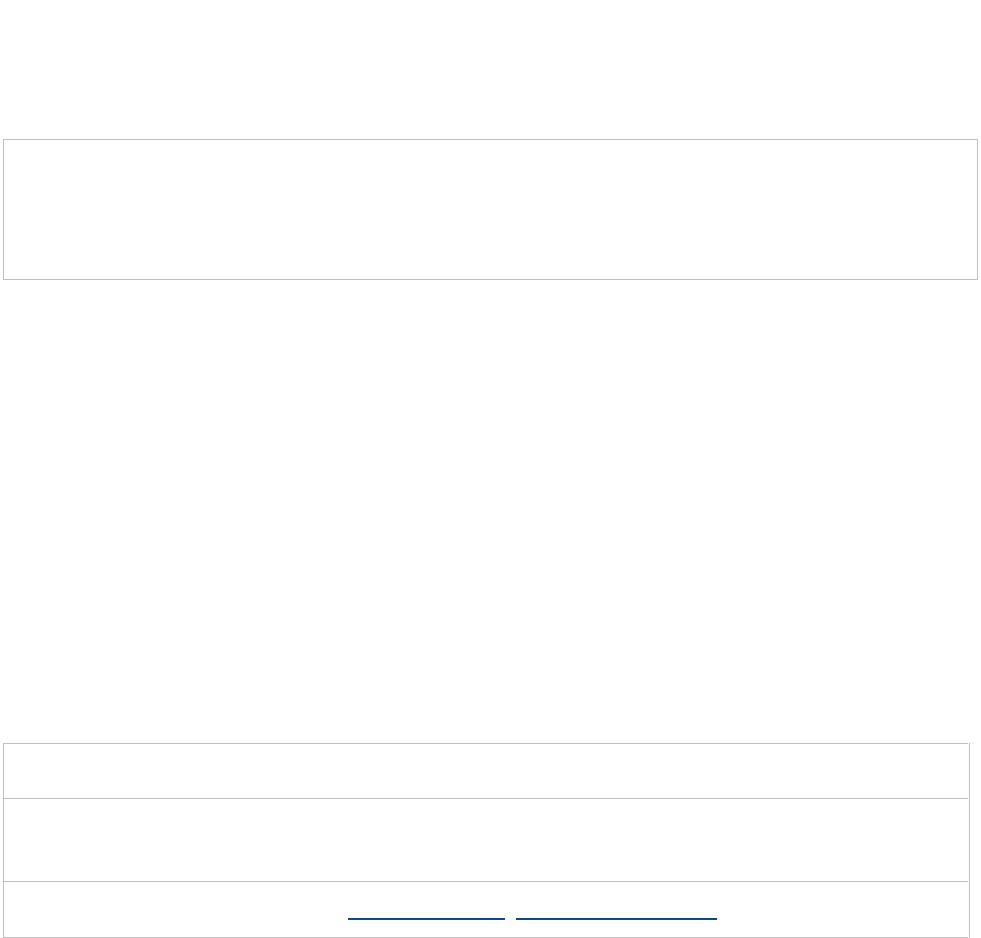DelaysinClimateTransitionCanIncreaseFinancialTailRisks:AGlobalLessonfromaStudyinMexicoDimitriosLaliotisandSujanLamichhaneWP/23/175IMFWorkingPapersdescriberesearchinprogressbytheauthor(s)andarepublishedtoelicitcommentsandtoencouragedebate.TheviewsexpressedinIMFWorkingPapersarethoseoftheauthor(s)anddonotnecessarilyrepresenttheviewsoftheIMF,itsExecutiveBoard,orIMFmanagement.2023AUG©2023InternationalMonetaryFundWP/23/175IMFWorkingPaperMonetaryandCapitalMarketsDepartmentDelaysinClimateTransitionCanIncreaseFinancialTailRisks:AGlobalLessonfromaStudyinMexicoPreparedbyDimitriosLaliotisandSujanLamichhaneAuthorizedfordistributionbyHirokoOuraAugust2023IMFWorkingPapersdescriberesearchinprogressbytheauthor(s)andarepublishedtoelicitcommentsandtoencouragedebate.TheviewsexpressedinIMFWorkingPapersarethoseoftheauthor(s)anddonotnecessarilyrepresenttheviewsoftheIMF,itsExecutiveBoard,orIMFmanagement.ABSTRACT:Thispaperexploresanovelforward-lookingapproachtostudythefinancialstabilityimplicationsofclimate-relatedtransitionrisks.Wedevelopanintegratedmicro-macroframeworkwithanewclassofscenariocalleddelayed-uncertainpathways.Anadditionalstochasticfinancialmodelinglayerviaajump-diffusionprocessisconsideredtocapturecontinuouslychangingrisks,aswellasthepotentialoflarge/suddenshocksinthefinancialmarkets.WeappliedthisapproachtostudytransitionrisksintheMexicanfinancialsector.Buttheimplicationsareglobalinscope,andtheframeworkiseasilyadaptabletoothercountries.Wequantifytheprojectionsoffuturedistributionsofvariousriskmetricsand,hence,theevolvingtailrisksduetocompoundingeffectsfromdelaysintransitioningtoalow-carboneconomyandtheconsequentuncertaintyofthefuturepolicypath.Wefindthatthelongerthedelaysintransition,thelargerthefuturetailfinancialrisks,whichcouldbematerialtotheoverallsystem.RECOMMENDEDCITATION:Laliotis,D.andS.Lamichhane.2023.“DelaysinClimateTransitionCanIncreaseFinancialTailRisks:AGlobalLessonfromaStudyinMexico.”IMFWorkingPaperNo.175JELClassificationNumbers:E44,G12,G21,G32,Q54,Q58Keywords:Authors’EmailAddresses:Climatechange;transitionrisk;greenhousegasemissions;financialstability;stresstesting;defaultrisk;jump-diffusionDLaliotis@imf.org;SLamichhane@imf.orgWORKINGPAPERSDelaysinClimateTransitionCanIncreaseFinancialTailRisks:AGlobalLessonfromaStudyinMexicoPreparedbyDimitriosLaliotisandSujanLamichhane3ContentsI.Introduction..........................................................................................................................................5II.ClimatePolicyrisksinMexico..........................................................................................................10III.ModelingFramework...........................................................................................................................12A.Micro-MacroApproach..........................................................................................................................12B.TransitionScenariosandStochasticFinancialModel...........................................................................18IV.ImpactonCorporateandFinancialSectors....................................................................................24V.Conclusion.........................................................................................................................................29AppendixI.MappingCGEModelSectorstoCorporateSectorsandNAICSSectorClassification.........................304Introduction1Climatechangeisalreadygeneratingunprecedentedimpactsaroundtheworldonvarioussegmentsoftheglobaleconomyandhumansociety.TheIntergovernmentalPanelonClimateChange(IPCC),theUnitedNationsbodyforadvancingthescienceonclimatechange,highlightsthattheadverseeconomiceffectsattributabletohuman-inducedclimatechangeareincreasinglybeingobserved,leadingtolarge-scalelossesanddamagestonatureandhumansocietyaroundtheworld(IPCC2022).Physicalhazardsandtheirimpacts—suchasincreasingfrequencyandintensityofextremeclimateevents(forexample,hurricanes,floods,drought,andwildfires)—areprojectedtoincreasefurtherwithglobalwarming.Limitingglobalwarmingrequiressignificanteffortsinandcommitmentstoreducingglobalgreenhousegas(GHG)emissions.Suchactionscouldhaveamaterialeconomicandfinancialimpactonemissions-intensivefirms/sectorsandalsohouseholdsandgovernmentsviadifferentchannels.Thus,transitionrisksariseastheeconomymovestowardalow-carboneconomy,whichcanimpactvarioussegmentsoftheeconomyandthefinancialsector.WorldwideconsensusisbuildingontheneedtointroducestrongerpolicyactionstolimitGHGemissionsandtransitiontoalow-carboneconomy.DuringCOP26,the2021UNclimatesummit,policymakersaroundtheworldmadenewclimatepledgesanddiscussedplanstoreduceemissionstoavertseriousdamagestotheclimatesystem.AtCOP26,morethan120countries,representingabout70percentofglobalemissions,pledgedtobringemissionstonetzerobyaround2050.Andgiventheexposureofthefinancialsystemtotheeffectsofclimatechange,globalregulatorsandcentralbanksincreasinglyrecognizetheneedtoassessandminimizethoseimpactsonfinancialstability.However,despitethewarningsfromtheIPCConrisingglobaltemperatures,moreambitiousanddecisiveactionstolimitGHGemissionsarestillwanting.AccordingtoClimateActionTracker(2022),anon-profitresearchorganizationthattracksprogressongovernments’pledgesandactionstoaddressclimatechange,theglobalengagementsincetheCOP26havebeenweakened,especiallyinthewakeoftheRussia-Ukraineconflict.Progresshasstalledonmoreambitious2030climatetargets.ThiswasalsoevidentfromrecentCOP27wherestrongerglobalclimateambitionsrelativetoCOP26werelargelyabsent.Andwithoutincreasedpolicyresponse,theworldcouldemitsignificantlymoreGHGs,potentiallyincreasingtheearth’stemperaturetowellabovethe2°Cupperlimitforglobalwarming—withthegoalof1.5°C—establishedbytheParisAgreement.Infact,globalnon-renewable-energy-andfossil-fuel-relatedCO2emissionsin2021bouncedbackalmosttopre-COVID-19pandemicemissionlevels(IEA2021;EDGAR2022).Thelongertheglobaldelaysintransitioningtoalow-carboneconomy,themorestringentthefuturepolicymeasuresmightneedtobetoattaintheclimategoals.Ifclimatemitigationpolicyactionsaredelayedatthepresent,itishighlylikelythatfutureactionsrequiredtokeeptheglobaltemperaturewellwithinacceptablelimitswillneedtobeevenmorestringentthantheywouldhavebeenonanearliertransitionpath.Theworldishighlydependentonnon-renewableenergysources(fossilfuels)—suchascoal,oil,andnatural1Thisworkdevelopedfromclimateriskanalysisworkduringthe2022MexicoFSAP.WewouldliketothankVikramHaksar(FSAPmissionchief,IMF),HeedonKang(deputymissionchief,IMF),FSAPteammembers,andMCM-FSclimategroupfortheirvaluablecommentsanddiscussions.WearegratefultoJeanChateauforprovidinguswiththeCGEmodeloutputs.WealsothankmembersofMexicanFinancialAuthoritiesforahighlyproductiveengagement,discussions,andfeedback.gas—whichdominatethetotalenergysupply(Figure1),whereasrenewablesources,suchashydro,solar,andwindpower,constituteaminorportion.InadditiontoCO2emissionsfromburningoilandnaturalgas,theyarealsoasignificantsourceofmethaneemissions,whichhavesignificantlymoreglobalwarmingpotentialthanCO2.Inthisregard,powergenerationandtransportationareamongthekeysectorsdrivingemissions:theycontributedabouttwo-thirdsoftotalglobalemissionsin2019(IEA2021).Thishighdependenceonnon-renewablesandthedominanceofGHG-intensivesources/sectors,coupledwithpolicyuncertaintyanddelaysinimplementingglobalmitigationefforts,signalsthepotentialforsignificanttransitiontailriskstotheeconomy.Thisriskcomesinadditiontothecontinuedincreaseinthefrequencyandseverityofextremeclimate-relatedevents.Figure1.SourcesofGlobalEnergySupplyPolicymakersareincreasinglymakingeffortstoassessandquantifyclimate-relatedriskexposuresandvulnerabilitiesforthefinancialsystems.Thishasledtothedevelopmentofanewandrapidlygrowingliteratureonclimate-risk-relatedfinancialstabilityandpolicyanalysisissues,aspolicymakersareincreasinglyawareofthesignificantrisksposedbyclimatechange.Forexample,theanalysisofclimate-relatedriskswithimplicationsforfinancialstabilityisamountingpriorityoftheFinancialSectorAssessmentsProgram(FSAP)attheInternationalMonetaryFund(IMF)(seeAdrianetal.(2022)formoredetails).2Agrowingnumberofcentralbanksandinternationalinstitutionsaroundtheworldhavestartedexploringscenario-basedanalysisandstresstestingexercisestoassess,quantify,andmanageclimate-relatedfinancialrisks.Forexample,seethestudiesandreportsinDeNederlandscheBank(2018),BankofEngland(2019),BankofCanada(2020),Bankof2FSAPisanimportantinstrumentoftheIMF’ssurveillanceandrepresentsacomprehensiveandin-depthassessmentofacountry’sfinancialsector.Sinceclimateriskanalysisisatanearlystageofdevelopment,oneofthekeygoalsoftheanalysisinFSAPsistoraiseawarenessoftherisksandtheneedfornewriskmanagementtoolstobedevelopedbythebanksandthesupervisorybodies.Theserequirementswillbequitedifferentacrossvariousjurisdictions,giventheuniquenatureofrisksarisingfromclimatechange.RecentFSAPshavestartedaddressingbothtransitionandphysicalrisks,forexample,inNorway(IMF2020),GrippaandMann(2020),Chile(IMF2021),UK(IMF2022a),Philippines(IMFandWorldBank2021),Mexico(IMF2022b),andUruguay(IMF2022c).6France/ACPR(2021),andEuropeanCentralBank(2021).3BaudinoandSvoronos(2021)surveyandcomparebankstresstestingpracticesforclimatechangeriskbycentralbanksandpolicymakersaroundtheworld.Battistonetal.(2021)provideanoverviewofvariousmethodologicaldevelopmentsinadvancingourunderstandingofclimate-relatedfinancialstabilityrisksandcallforcontinuedinnovations.Thisisespeciallyimportantgiventheuniquefeaturesofclimaterisks,suchasambiguity/deepuncertainty,non-linearities,andsoon,renderingtraditionalapproacheslargelyinadequate.Forexample,traditionalriskanalysistoolsgenerallyrelyonhistoricaldataandhencearebackwardlooking.Thisfeatureisnotparticularlywellsuitedtoassessingfinancialstabilityrisksfromtheever-complexandevolvingnatureofclimaterisks,manyofwhichareexpectedtomaterializeinthefuture,withanuncertainhorizon.Further,highlyimpactfuland/orlarge/suddennegativeshocks/eventscouldsharplyincreasefinancialstabilityrisks,suchassomekindofgreenswanrisks(Boltonetal.2020)orclimateMinskymoment(seeUnitedKingdom(IMF2022a)).Thiscallsforforward-lookinganalysiswherestresstestsandscenario-basedmethodsaregenerallypreferred,giventheirinherentlyforward-lookingandyetflexiblenature.4Thispapercontributestotheliteratureonclimate-relatedfinancialstabilityanalysisbydevelopinganovelforward-lookinganalyticalapproachtotransitionriskanalysis.Inparticular,webuildanintegratedmicro-macroframeworkandintroduceanewclassofscenariocalleddelayed-uncertainpathwayswithastochasticfinancialmodellayerusingajump-diffusionprocess.Itismacrobecauseweuseprojectionsofmacro-sectoralpathwaysforvarioussegmentsoftheeconomy.Itismicrobecauseweusemicro/firm-levelbalancesheetinformationandsimulationsinprojectingrisksforwardintime.Tomodelthefuturepolicyuncertaintyregardingwhenandhowgloballycoordinatedactionswilltakeplacegivencurrentdelays,thestandarddeterministicscenarioprojectionpaths(suchasthoseusedinstresstestingexercisesliketheNetworkforGreeningtheFinancialSystem(NGFS)scenarios)areaugmentedusingasimplebutrobustbinomialtreeevolutionstructure.Andtocapturetheeffectsinducedbytheglobaldelays/policyuncertaintyinthefinancialmarkets,includingthepotentialoflarge/suddenmovements,ajump-diffusionstochasticprocessisusedtomodelrelevantfinancialvariables(here,corporatespreads).Tosummarize,thefutureincreaseintailrisksduetodelaysintransitioncoupledwithincreasedpolicyuncertaintyregardingwhenandhowsuchglobalactionsmighttakeplaceislargelyunexploredinthefinancialstabilityliterature.Thispapercontributesbyadvancingunderstandinginthisregard.Giventhemodelwiththeuncertaintystructure,weareabletoquantifytheprojectionsoffuturedistributionsofdifferentriskmetricsand,hence,tailriskaswell.Thedelayed-uncertainpathwaysimplythatateachpointintimeinthefuture,themoreaccuratewaytodescribethevariousriskmetrics,suchascorporate/sectoralprobabilitiesofdefault(PDs)andbankcapitalimpact,isviaprojectionsoftheirtime-varyingdistributions.Thisisinsharpcontrasttotheillustrationofoneormoreadversescenariooutcomesasdeviationfromasuitablydefinedbaseline,asdoneinstandardscenario-basedstress-testinganalysis,whichinvolvespointprojectionsofriskmetricsonescenarioatatime.Assuch,ourapproachalsotakesacross-sectional3TheFederalReserveBoardintheUnitedStatesalsorecentlyannouncementthepilotclimatescenarioanalysisexerciseforthesixlargestbanksinthecountry.Thisistobelaunchedinearly2023andconcludedbyyear-end.Thestatedprimaryobjectiveistoenhancetheabilityofsupervisorsandinstitutionstoquantifyandmanageclimate-relatedfinancialrisks.4In2017,theTaskForceonClimate-relatedFinancialDisclosures(TCFD)oftheFSBpublisheditsrecommendationsonclimate-relatedfinancialdisclosure,inwhichakeycomponentemphasizedscenario-basedassessmentsoftheimplicationsofclimate-relatedrisks.7perspectivetoaddressthecritiquethatasomewhatarbitraryandnon-stochasticchoiceofstresstestscenarioapproachaffectsthereliabilityofriskanalysis.5WeappliedtheapproachtostudytransitionrisksintheMexicanfinancialsector,wherethekeyimplicationsandtakeawaysareglobalinscope.Thescenariosexploredwerelargelydrivenbyglobalpolicyassumptionsandactionsthatgeneratepathsforallthecountriesinthemodel,includingMexico(discussedbelow).Thus,whilethespecificapplicationisforMexico,theimplicationsareindeedglobal,andtheframeworkcaneasilybeadaptedforothercountries.Forthispurpose,twosetsofscenarioswereexplored.Thefirstsetessentiallyfollowsastandardstresstestingparadigm,thatis,withabaselineandadversescenario(s)setting,asdiscussedabove.Thebaselinereflectsacurrentunchangedpoliciesscenarioandtheadverseisanorderlytransitionscenario(similarinspirittothatoftheNGFS),broadlyinlinewithlimitingtheglobaltemperateincreasetowithin2°Cbytheendofthecentury(called“globalaction”)withcountriesactingearlyandgraduallytoimplementclimatepolicies.However,despitetheglobalconsensusontheneedtotakestrongpolicyactions,itisuncertainwhenandhowsuchglobalactionswouldmaterialize.Delaysgiverisetofuturepolicyuncertainty,whichcanhaveimportanteconomiceffects,asfutureriskscouldbecompounded.Thus,thesecondsethelpscapturesuchfuturepolicyuncertaintyandassociatedrisks,asitconsistsofadisorderlyanduncertaintransitionenvironment(called“delayeduncertain”).Thisischaracterizedbyasimplebinomialtreeevolutionandanembeddedlayerofstochasticmodelofcorporatespreadsviathejump-diffusionprocesstocapturecontinuouslychangingrisksaswellaslarge/suddenmovementsinthefinancialmarkets.Thisisasimplifiedbutrobustwayofmodelinguncertainty.Thekeydistinctionisthatsuchanuncertaintystructureallowsustoquantifydistributionsofvariousriskmetrics,whichisgenerallynotpossibleinastandardstresstestingsetting,unlikethefirstset,whichconsistsofadeterministicpathofearlyglobalaction.6Theanalysisflaggedimportantsectoralheterogeneityoftheexposuretotransitionrisksandincreaseddownsidetailriskstothecorporateandfinancialsectorsfromdelays.Undertheglobalactionscenario,whereallcountriesactearly,theaggregateimpactonthefinancialsectorismodest,thoughsomesectorsandbanksappearmoreexposed.However,thedelayed-uncertainpathwaysrevealedthepotentialforsignificantriskstocorporatesandbanks.Forexample,fromthesequencesoftime-varyingdistributionofPDsacrosssectors,giventheuncertaintyinfutureperiods,theanalysisfoundthattherighttailofthePDdistributioncouldbecomesignificantlyheavierwithincreasinglylongerdelays.Specifically,thechemicalsandnon-metallicsegmentsofthemanufacturingsectorinMexicoseemedthemostvulnerabledespitetheirsoundinitial-statecorporatedistressmetricsrelativetomanyothersectors.Interestingly,eventhoughsomesectorsarenotasemissionintensiveintheirproduction,liketheconstructionsector,theycouldstillbenegativelyaffected5Notethatinthecontextofafullystochasticanalysis,theusualcharacterizationregardingdiscussingoutcomesasdeviationsfrombaseline(orasdifferentadversescenarios)isnotasmeaningful.Thisisbecauseoneisabletocharacterizetheentiredistributionwheredifferentfeaturesofthetailscanbediscussed,thatis,amoreprobabilisticperspectivecanbeexplored.Thisisgenerallynotpossiblewithusualscenarioanalysissettingbyconstruction.Ourtwosetsofscenarios(discussedabove)alsoservetohighlightthedifferencesinoutcomesthatonecouldexpectfromastochasticversusnon-stochasticsetup.6Notethatwhilethescenariounderconsiderationinvolveseconomy-widecarbonpricesforallGHGs,therecouldalsobevariousalternativetransitionpolicyinstrumentstoreduceemissions,suchasemissiontradingsystems,subsidiestorenewableenergyetc.Inthisregard,carbonpricescanbeseenasamodellingtoolthatallowsforatractableandparsimoniouswaytostudyfinancialsectorimpactofageneraldecarbonizationscenario.Hence,thecarbonpricesimplicitlyreflectthedegreeofoverallpolicyambitionandtheequivalenteffectsofvariouspoliciesmixes.Further,giventheflexibilityofthemodel,impactofvariouspolicymixescanalsobeusedinourapproachsincethesemacro/CGEmodeloutputsaretakenasgivenscenariopathsandareuseddirectlyasaninputinpolicyrelatedfinancialstabilityanalysis(suchasstresstesting).8dependingontheirinitialfinancialconditions,astheanalysisrevealed.Further,whereasthebankcapitalimpactappearedsomewhatmodestundertheglobalaction,delayed-uncertainanalysisalsorevealednon-trivialincreasesinthetailriskofthebankcapitalimpact,suggestingthepotentialformaterialimpactinthefuture.Akeyinsightoftheanalysisisthatthelongerthedelaysintransition,thelargerthefuturetailrisks.Inoursetup,futurepolicyuncertaintygeneratesmaterialrisksfromthefinancialmarketschannel.Delaysintransitiongeneratesaneedtocatchupwithstrongerfuturepolicyactiontocontainglobalwarming.Theriskiscompoundedduetotheuncertaintyofwhenandhowsuchafuturepolicywouldbeimplemented.Thiscouldleadtoareassessmentofrisksincorporatesectorsaroundtheworld,includinginMexico,withincreasedmarketriskandvolatility.Thiscouldfurtherleadtodisruptionsinequityanddebtcapitalmarkets,andasharpriseincorporatespreads,riskpremium,andsoon,therebyamplifyingriskstothesystemandincreasingtailriskstofinancialstability.Evenintheabsenceofstrongtransition-relatedpolicyactions,riskfromfinancialmarketscouldmaterialize,giventheforward-lookingnatureofglobalinvestorscoupledwithincreasingawarenessofclimatechangeissues.Theanalysissupportsthecaseforanearlyandorderlytransitiontoalow-carboneconomy,tomitigatethetailriskoflargeractiononfuturemeasurestoachieveclimategoals.Theanalysisabstractsawayfromconsiderationsofphysicalrisks,whichimpliesthatdelaysintransitioncouldfurtheraffectthevaluationsofwide-rangingassetsgiventhepotentialfutureincreaseinthefrequencyandseverityofvariousphysicalhazards.Further,theanalysisalsodoesnotcapturethepotentialgeneralequilibriumeffectswhichcouldleadtofeedbackeffectsfromfinancialsectortotherealeconomy.Giventhislimitation,ourresultscouldalsobepotentiallyunderestimatingtheimpacttransitiondelaysandresultinglikelihoodofhigherimpactofphysicalrisks.Theframeworkdevelopedisgeneralwithglobalimplications,butspecificresultsneedtobeinterpretedwithcaution.Becausetheearlyversusdelayedactionsatthegloballevel(whereMexicoisoneofthecountries)arekeydriversofthescenariosandshocks,theMexico-specificoutcomespointatthepotentialforlargerclimate-relatedtransitionriskstocountriesacrosstheglobe.WhiletheMexico-specificresultsdidnotfindimminentsystemicrisktothecountry,therelativelymildresultsneedtobeinterpretedwithcaution,givenvariousdatalimitations,simplifyingassumptions,andotheruncertaintiesnotaccountedforintheMexico-specificanalysis.Inparticular,theanalysisinMexicocoveredonlythecorporateloanportfolioofthecommercialbankingsector,wherethedatalimitationsprecludedamoregranularanalysis.7Nevertheless,theanalysisdiscoveredareasofvulnerabilitiesinthecorporatesector,suggestingthattherecouldbeotherrisksthatstillneedtobefullyexplored.However,themethodologicalapproachitselfisnotconstrainedbydatalimitations.Assuch,ourframeworkcanbeeasilyadaptedwheneverbetterand/ormoregranulardataareavailable.Theapproachandmanyofthechannels/mechanismsweexploredaregeneralizableand,therefore,theargumentonthepotentialforsignificantdownsidetailriskstofinancialsectorsacrosscountriesworldwide,dependingontheirexposuresandvulnerabilitytotransitionrisks,remainsvalid.7EventhoughtheMexico-specificexercisemainlyrelatestothecorporatecreditriskeffects,thisisarguablyoneofthemostimportantchannels,becausethecorporateportfolioconstitutesthelargestbankingportfolioexposures.Further,transitionpoliciesgenerallyhaveimmediateconsequencesforcorporates.However,futureanalysiscouldconsiderotherchannelsaswell,suchasmarketrisks,effectsonconsumerportfolios,andsoon.Notethatduetotheheterogeneity,eachcountrywillbeaffecteddifferentlyfromglobaltransitionpolicies,giventheeconomicstructure,policyambitions,andsoon.Thus,whiletheframeworkisgeneral,therewouldbedifferentialimpactacrosscountries-sectors.9Theinsightfromourpaperisdirectlyrelevanttoinformingclimate-relatedpolicyaroundtheworld.Ourframeworkcanbereadilyintegratedintoexistingpolicyframeworkstobetterinformclimate-relatedriskassessment.Becausetailrisksgetlargerthelongerthedelaytowardalow-carboneconomy,continuedvigilanceisrequiredatthegloballevel.Thisisespeciallyimportantbecausedespitecoveringonlylimitedchannelsofrisksinourspecificapplication,wewereabletodetectthepotentialformaterialfuturedownsidetailrisks.8Therestofthepaperisorganizedasfollows.SectionIIprovidesabriefoverviewoftransitionpolicyrisksinMexico.SectionIIIpresentsthemodelingframeworkandthecontextofapplicationinMexico.SectionIVrevealstheresults,andsectionVconcludes.ClimatePolicyRisksinMexicoMexicohassignaleditscommitmenttoemissionsreductiontargets,butmoreeffortwillbeneeded.AccordingtoClimateActionTracker,anon-profitresearchorganizationthattracksprogressongovernments’pledgesandactionstoaddressclimatechange,furtherstepsbeyondthecurrentpoliciesofandcommitmentsbyMexicowillbeneededtoadheretotheglobalwarminglimitof1.5°CbasedontheParisAgreement.Nevertheless,MexicomadestridestoexpanditsclimategoalsatCOP26(andupdateditscommitmentsattherecentCOP27),wherethecountryjoinedtheGlobalMethanePledgeandtheDeclarationonForestsandLandUse.TheGlobalMethanePledgeaimstoreduceglobalmethaneemissionsbyatleast30percentby2030relativeto2020levels.Thisisimportantbecausetheglobalwarmingpotentialofmethaneisabout28timeshigherthanthatofCO2.TheDeclarationonForestsandLandUseisacommitmenttohaltandreversetheissuesofdeforestationandlanddegradationby2030.Mexicohasalsopledgedtoacceleratethetransitiontorenewableenergysources,suchaswind,hydro,andsolarpower,tosupportitscommitmentsundertheParisAgreement.Thehighdependenceoncarbon-sourcedenergyandcommitmentstoreduceemissionsraisetransition-relatedrisksforMexico.ThecountryisthesecondlargestemitterofGHGsinLatinAmerica,afterBrazil,withoneofthehighestpercapitaemissionslevels,andasignificantportionofthatcanbeattributedtotheenergysector.Further,Mexicoishighlydependentonnon-renewableenergysources,asitstotalenergysupplyisdominatedbyfossilfuelsandothernon-renewableenergysources,asistheglobalsupply(Figure1).Oilandnaturalgasamountedtoabout85percentofthetotalenergysupplyinMexicoin2020).AlargeportionoftotalCO2emissionsinMexicoisconcentratedinthepowergenerationindustry,followedbymanufacturingandtransportation(Figure2,toppanel).About38percentofthetotalCO2emissionsin2018wasattributabletotheutilities/powergenerationsector,about25percenttothemanufacturingsector,andabout16percenttothetransportationsector.Theminingsector,whichincludesoil,7Notethatadditionalrisksandensuingfatteningoftailsinthedelayed-uncertaincasesarelargelydrivenbyshocksinthefinancialmarketslayer.ThisisbecausethebinomialtreeevolutionwasconstructedusingthedeterministicsectoralpathsfromtheCGEmodel.However,ifsuchpathwaysweretobegeneratedfromastochasticmodel,onecouldalsodirectlyaffecttheuncertaintyofthesepaths(forexample,byaffectingthevolatilityofpathsthatcouldgeneratelargerdispersionofsectoralpathways).Thiswouldnaturallyleadtoevenheaviertailsofvariousriskmetricsinadditiontothoseduetothefinancialmarketschannelalone.Fullyexploringstochasticmacro-sectoralpathwaysisanintriguingandchallengingfutureresearchtopiconitsown.Assuch,itisnotyetaregularpartofthepolicyanalysistoolkit.Inthisregard,ouranalysiseffectivelylaysoutaconceptualframeworkthatshowcases,viaasimplebinomialuncertaintystructure,howsuchafull-fledgedstochasticanalysiscanbesetuptoobtainamoredistributionalperspectiveforfinancialstabilitypolicyanalysis.10gas,andcoalextraction,accountsforonlyabout11percentofoverallCO2emissions,becausethissectorisnotasemissionintensiveduringtheextractionphase.Instead,thesectorfacesrisksmostlyfromotherchannels,suchasdemand,becausetheproductsarehighlyemissionintensiveduringthecombustionphase.Thiscouldsignificantlyaffectthesectorastheworldtransitionsawayfromfossilfuels.Allothersectorscombinedconstituteabout10percentoftotalCO2emissions.Figure2.CarbonDioxide(CO2)EmissionsandFinancialSector’sSectoralCreditExposureNote:Theemission-intensivesectorsareshowninred.11TheMexicanfinancialsectoralsohassizablecreditexposurestotransition-vulnerableeconomicsectors(Figure2,bottompanel).About37percentofthecommercialbankingsystem’scorporatecreditisconcentratedinemission-intensivesectors.Thelargestexposureisconcentratedinthemanufacturingsector,accountingforabout15percentoftotalcredit.Exposurestotheminingsector,whichincludestheoil,gas,coalextractionsegments,isrelativelysmall,at4percentoftotalcredit.ModelingFrameworkA.Micro-MacroApproachThemodelingframeworkfortransitionriskanalysiscanbebroadlydescribedasanintegratedmicro-macroapproach.Figure3presentstheschematicoftheoverallframeworkthattakestransitionriskscenariosforvariouseconomicsectorsasinputsandallowsforadding/exploringothershocks,suchasthosefromfinancialmarkets.Thepathsofthesescenariosarestructurallylinkedtofirm-levelcorporatevulnerabilityindicators.Finally,theimpactontheseindicatorsistranslatedintocorporatecreditriskpathsusinganestimatedbridgeequation,whichistheneventuallytranslatedintoimpactonbankcapitalbasedonabank’screditexposurestovarioussectors.Thus,theframeworkisflexibleenoughtotakeinputfromvarioussourcesandexternalmodelingframeworkssuchthatallthemodulesarebroughttointeracttogetherinaninternallyconsistentway.Figure3.TransitionRiskAnalysis:AnIntegratedMicro-MacroFrameworkSource:IMFstaff.Weobtainedtransitionriskscenariosusingacomputablegeneralequilibrium(CGE)modeltoobtaingranularmacro-sectoralpathways.Thismodel(theIMF-ENVmodel)wasrecentlydevelopedbytheIMFresearchdepartmentandisdocumentedinChateauetal.(2022).Itisarecursive-dynamic,multi-regional,multi-sectoralmodel.Givenitssectoralgranularity,thisclassofCGEmodelslargelystudylong-rundynamicsandallocationofresourcesacrossvarioussectors.Thus,CGEmodelsarehighlysuitableforstudyingthelong-runimpactofclimatemitigationanddecarbonizationpolicies.TheIMF-ENVmodelcovers25regions(includingMexico)andgroupscountriesintohigh-,middle-,andlow-incomecountries.Themodelhas37distinctsectors,allowingforagranularanalysisofsectoralimpactsoftransitionpolicies.Thescenariosarealsobroadly12anchoredtothehigh-levelNGFSscenarionarratives(oforderlyanddisorderlyscenarios)andalignedwithIPCCtemperature/emissiontargets.9SectionCprovidesmoredetails.Thesepolicyscenariosareappliedtogeneratemulti-yearprojectionsoffirm-levelprobabilitiesofdefault(PDs),whicharefurtheraggregatedintoscenario-dependentsectoralPDpaths.ThesePDpathsarethentranslatedintobanks’aggregatePDpathsweightedbytheircreditexposuretovulnerablesectors.Detailsofvariouscomponentsofthisapproach,summarizedinFigure3,arediscussedinwhatfollows.Thecorporatemicrodatausedintheanalysismostlyconsistedofasampleoflarge/listedMexicanfirms.ThedatasamplewassourcedfromDataStreamandS&PCapitalIQ,andthesampleperiodcoversbalancesheetdatafrom2002to2020.Onaverage,thereareabout100totalfirmsinthesampleeachyear.Thesampleoffirmsselectedfortheanalysisbelongtothesectorsthataremostemissionintensive(Figure2).Ingeneral,limitedusable/reliabledataareavailableonotherMexicanfirms,especiallyforsmallandmediumsizeenterprises(SMEs),whichconstitutealargenumberofMexicancorporates.Thisdatalimitationconstrainsthescopeoftheanalysisandtheabilitytogeneralizeresults.However,asmentionedbefore,theframeworkitselfdoesnotdependonthedatalimitations,becauselarger/moregranulardatasets,wheneveravailable,canalwaysbeusedtoincreasetheprecisionandgranularityoftheanalysis.Largecorporatesdominatethebankingcreditportfolio,allowingformeaningfulanalysis.Only2percentoftheentireuniverseoffirmswithoutstandingloanfacilitiesacross44commercialbanksareconsideredlargefirms,basedonthehistoricalmaximumloanamount(astandardcriterionusedbytheMexicancentralbank,Banxico.TherestareSMEs.However,theselargefirmsaccountformorethan65percentofoutstandingbankcredit.10Thus,thereisadisproportionaterepresentationoflargecorporatesinthebankingsystem,withahighconcentrationoftheseamongthelargest10banksconsideredintheanalysis.Assuch,itispossibletoobtainimportantinsightsregardingtheanticipatedoverallimpactonewouldexpectacrossvarioussegmentsoftheeconomy.11Thecorporatedatasamplecontainskeybalancesheetandprofitandloss(P&L)itemsrequiredfortheframework.Theseincludeearningsbeforeinterestandtaxes(EBIT),salesrevenue,costofgoodssold,interestexpenses,average/effectiveinterestrates,totaldebt,totalassets,currentassets,andcurrentliabilities.Thesearesomeofthecommonlyusedvariablesforanalyzingthefinancialhealthoftheindividualfirmsandeconomicsectorsastheseareusedforconstructingvariousindicatorsofcorporatedistress,discussedbelow.9NotethattheCGEmodelisbasedonaneoclassicalframeworkanddealswithrealvalues/economyandisidealforstudyingstructuraltransformations,trade,decarbonization,development,andsoon,whicharelong-runissues.Thus,thefocusisonthelong-termreallocationofresourcesacrossdifferentsectors/regions.However,theyarenotadaptedtostudybusiness-cycle,financial,andmonetaryissues.Giventheabsenceofmoneyandfinancialmarketvariables,theteamwasabletoexploreanadditionalfinancialmodelinglayerwithintheframework(seesectionC).10Thesampleoffirmsintheanalysisrepresentabout42percentofthetotaloutstandingdebtofthenonfinancialcorporatesector.11SomeoftheeconomicsectorsoftheCGEmodelweremanuallymappedtoaggregatedsectornames.Thesenamesmimicascloselyaspossiblethesectorsinthetwo-digitNorthAmericanIndustryClassificationSystem(NAICS)toeventuallymapthesectoralimpactintoimpactonthebanks.ThislaststepisneededbecauseMexicanbanksidentifythesectorforagivenloantoacompanybasedonNAICScodes.TableA1inAppendixIprovidesmoredetailsonthismapping.13CorporatesalesrevenuesconstitutethemainstructurallinktothesectoraloutputandcarbonpricepathsgeneratedbytheCGEmodelunderdifferentscenarios.ThefollowingrecursiveevolutionfortheEBITisusedtomapthescenario-dependentsectoralpathwaysoutputoftheCGEmodelforeachfirmbasedonitssectoralaffiliation(firmandsectorindexesomittedfornotationalsimplicity):𝐸𝐸𝐸𝐸𝐸𝐸𝑇𝑇𝑡𝑡=𝐸𝐸𝐸𝐸𝐸𝐸𝑇𝑇𝑡𝑡−1+𝐹𝐹𝑡𝑡∗[𝑆𝑆𝑆𝑆𝑆𝑆𝑆𝑆𝑠𝑠𝑡𝑡−1−𝐺𝐺∗𝐶𝐶𝐶𝐶𝐶𝐶𝑆𝑆𝑡𝑡−1]−𝐶𝐶𝐶𝐶𝐶𝐶𝐶𝐶𝐶𝐶𝐶𝐶𝑇𝑇𝑇𝑇𝑥𝑥𝑡𝑡where𝐹𝐹𝑡𝑡isrelatedtothesensitivityofsalestothegrossoutput/grossvalueadded(GVA)pathsper-industry,𝐺𝐺istheelasticityofcostofgoodssold(COGS)tosalesrevenues(Sales),and𝐶𝐶𝐶𝐶𝐶𝐶𝐶𝐶𝐶𝐶𝐶𝐶𝑇𝑇𝑇𝑇𝑥𝑥𝑡𝑡isthedirectadditionaloperatingcostduetofirm-levelemissionsprojectionsandscenario-dependentcarbonprices,estimatedascarbonpricetimesemissions(intCO2eq).12Thefactor𝑭𝑭𝒕𝒕isdifferentforeachsector(andcommonforfirmsinthesamesector)sinceitislinkedtotheprojectedtransitionpathwaysfromtheCGEmodel,whichisdifferentacrosssectors.Thesesectoralpathsarethenmappedintoimpactonthesalesrevenuesofeachfirmbasedonsectoralaffiliation.Thisideallyrequiresfirstestimatingtheelasticityofsalestotheoutput/GVAofeachsectorbasedonregressinghistoricalsectorlevelsalesonsector-levelGVA.However,giventhelackofsufficientlygranulardatarequiredatthesectorallevel,anelasticityof1.5wasassumed.ThiswasinformedbysimilarestimationsinGrossetal.(2022),whoanalyzesimilarestimationsacrossmanysectorsforemergingeconomieswheretherelatedelasticityaveragedabout1.5.Thisimpliesthatinthepresentanalysis,thedifferenceswillbedrivenbythesectoralpathwayssinceelasticitiesacrosssectorsarefixed.TheelasticityGwasobtainedbypanelfixedeffectsregressionofchangesinthecostofgoodssoldtosalesgrowth,estimatedtobe0.97.Acarbontax,capturingthecostofemissions,wasconsideredasanadditionaloperatingcostsitematthefirmlevel,whichwouldfurtherreducenetearnings.Weusedprojectionsoffirm-levelGHGemissionsdatafromUrgentem(aprivatedatavendor)underthethreecategoriesofNGFSscenarios(hothouseworld/businessasusual,orderly,anddisorderly),becausetheCGEmodelscenariosweremadeconsistentwiththesecategoriesofNGFSscenarios.Thesedataweremergedwiththecorporatedatasample.Giventheuniquecarbonpricepathsforeachscenario(discussedfurtherinsectionB,ontransitionscenarios),theadditionalcostforeachfirmissimplycarbonpricestimestheGHGemissionprojectionsofeachfirm,thuscapturinggranularityintheanalysis.So,thecarbontaxcapturesthedirecteffectsofcarbonpricingpolicies,whereastheequilibriumeffectswouldbecapturedbytheimpactonthesalesrevenues.13Thesetwochannelsusedformappingtheimpactofclimatetransitionpoliciesintoimpactonfirmsstrikessomebalancebetweenthedatalimitationsandtherequirementsofafull-fledgedmicro-macroframework.12NotethatcarbontaxhereisasimplifyingexpressionthatismeanttorepresenttheoperatingcostcomponentoftheEBITandnottorepresenttheformalnotionoftax(sinceEBITbydefinitionexcludestaxes).Thus,carbonpriceseffectsarecapturedviaEBITelasticityandnotanyspecifictaxelasticity.Moredetailsareprovidedbelow.13Notethatonlyscope1emissionswereusedtobeconsistentwithviewingcarbontaxasadditionaldirectoperatingcost.Urgentemdatasetcontainscurrent/startingpointemissionsaswellasprojectionsofemissionsforfirmsinoursample,alignedwiththethreeNGFSscenariocategories(hot-house-world,orderly,anddisorderly)whichwereusedtogetherwiththeprojectionofcarbonpricesfromtheCGEmodel.Inabsenceofsuchgranularfirmlevelemissionsdatasets,itispossibletoalsousetheprojectionsofsectoralemissionintensityfromCGEorothersuitablemodeltoobtaintheoverallcarbontaxpathwaysaswehaveinouranalysis.14Thedirectimpactonthesalescomponentfeedsintootherfirm-levelvariablesduringthefirm-levelmicrosimulationofkeycorporatevariablesandtheeffectscanpotentiallyaccumulate.Theinitialimpactfromsectoralpathwaystocorporatesales(withconsiderationofothershocks,forexample,tointerestrates,discussedbelow)canaccumulateovertheperiodsandpotentiallybecompounded.Thisisbecauseofthedynamic,recursiverelationbetweenvariouscorporatevariablesduringthemulti-yearsimulation/projection.Thisrelationisbasedonanaccountingidentity(describedinTableA2inAppendixI).Thesesimulationsassumeconstantbusinessmodelsandtechnologyovertheprojectionhorizonwheretheeffectsareduetochangesinsales,costofgoods,andcarbontaxesinducedbytransitionscenarios,asdiscussedabove.Theadditionalshocktotheinterestratesandhence,costofdebtcapital,isconsideredonlyinthedelayed-uncertainscenario,asthatisdirectlylinkedtotheoutcomesinthefinancialmarkets,whicharenotcoveredintheCGEmodel.Thesimulationoftherelevantcorporatevariablesforwardintimeconditionalontransitionscenariosallowsforconstructingscenario-dependentpathsofthemaincorporatevulnerabilityindicatorsofinterest.Theseare(i)theinterestcoverageratio(ICR),definedastheratioofEBITtotheinterestexpenses,whichrelatestothesolvencyaswellasshort-termliquidityconditionsoffirms;(ii)theleverageratio(LR),definedastotaldebttototalassets,ametricrelevantforsolvencyconditions:and(iii)thecurrentratio(CR),definedascurrentassetstocurrentliabilities,whichrepresentsshort-termliquidityconditions.Theaccountingidentityandrecursiverelationsusedforprojectionseventually(asshowninAppendixI)helpconstructscenario-dependentpathsofthesevulnerabilityindicators).Thehorizonoftheanalysisisfiveyears(till2026),whichistypicalofthethree-tofive-yearhorizongenerallyconsideredinstandardstresstestinganalysis,suchasthoseintheIMF’sFSAPs.Thecorporatevulnerabilityindicatorsshowtheheterogeneousriskcharacteristicsofvariouscorporatesectorsatthestart.Figure4(toppanel)showsthatthemedianoftheICRandCRindicatepotentiallydiverseimpactofthescenariosonvarioussectors.Inparticular,theconstructionsectorstandsoutwithsignificantlylowlevelsofsolvencyandliquiditymetrics.Thisimpliesthatthissectormightbesensitivetoevensmallshocks.Figure4(bottompanel)alsoshowstheleverageratio,whichillustratesthepotentialimpactofcapitalstructureandcostofdebtcapital.Forexample,thechemicalsandnon-metallicsegmentandutilitieshaverelativelyhigherleverageratiosThestartinginterestratesrepresentanothersourceofriskembeddedintothevulnerabilityindicator.Theinitialmedianinterestcostsacrosssectors(Figure4,bottompanel)highlightsanotherimportantchannelofriskpropagationbecauseitisrelatedtothecostofdebtcapital.Itisdirectlylinkedtoriskpremiathatfirmsneedtopayinordertocompensateinvestorsinfinancialmarketsfortakingonrisks.Forexample,duetoasuddenshiftininvestorriskaversion,foravarietyofreasons(forexample,uncertainpolicyregime,potentiallingeringeffectsofgeopoliticalconflictsaroundtheworld,downsideriskstotheeconomy,andsoon,),therecouldbesuddenandlargeincreasesincreditriskpremiadrivinghighercorporatespreads.Whileextremediscontinuousmovementinfixed-incomemarkets,suchasbonds,arerelativelyrarecomparedwiththoseintheequitymarkets,theydooccuroccasionallyduringmarketdistressperiods,suchastheglobalfinancialcrisisortheCOVID-19crisis.Thismotivatestheexplorationofajump-diffusionmodelofcorporatespreads,discussedbelow.15Abridgeequationwasusedtoestablishastructurallinkbetweenthecorporatevulnerabilityindicatorsanddefaultrisksandformedthebasisofprojectingfirm-levelPDs.Thisstructuralrelationshipwasestimatedfollowingthepanelfixedeffectsregressionwithlogit-transformedfirm-levelPDs:𝑙𝑙𝑙𝑙𝑙𝑙𝑙𝑙𝑙𝑙(𝑃𝑃𝐷𝐷)𝑖𝑖,𝑡𝑡=𝛼𝛼𝑖𝑖+𝛽𝛽1𝐼𝐼𝐼𝐼𝑅𝑅𝑖𝑖,𝑡𝑡+𝛽𝛽2𝐶𝐶𝑅𝑅𝑖𝑖,𝑡𝑡+𝛽𝛽3𝐿𝐿𝑅𝑅𝑖𝑖,𝑡𝑡+𝜖𝜖𝑖𝑖,𝑡𝑡ThePDsareobtainedfromMoody’sEDFdatabaseforMexico.Thismeasureisaforward-lookingdefaultriskmeasure.Theright-sidevariablesarethecorporatevulnerabilityindicatorsthatattempttocapturetherelationbetweencorporatefinancialhealthconditionandtheimplieddefaultrisks.ThelogittransformedPDisusedtomakesurethattheprojectedPDsliewithintheunitinterval.Thesummaryofthisestimation(TableA3inAppendixI)showsthatPDsaremostsensitivetoleverageratio,followedbycurrentratioandinterestcoverageratio.ThesensitivityofPDstothevulnerabilityindicatorsaredrivenbyvariousfactors.First,thecoefficientsofthebridgeequationarequitedifferentacrosstheseindicators.Second,thepathsoftheseindicatorsarealsoaffectedbytheCGEmodel’ssectoralpathwaysandcarbonpricesalongthosepathsduringsimulations.Thus,duetomultiplefactorsaffectingthedynamicsoftheprojectedpathsofPDs(henceafull-fledgedmicro-macroframework),careneedstobetakenininterpretingtheoutputsoftheframework.Itisimportanttonotethattheright-handsidevariablesofthebridgeequationdonotcontainanymacro-financialvariables.Thisisbecausetheright-sideindicatorsarealreadyaffectedbythestatevariablesoftheeconomyconsistingofvariousmacro-financialvariablesinthehistoricaldatausedforestimatingthepanelregression.ThismeanstheprojectionoftheseindicatorsisdrivenbytheCGEsectoraloutputs,carbonprices,andothershocks,suchasthosetointerestrates.Forexample,thechangestosalesrevenueforeachscenario,asdiscussedabove,wouldaffecttheEBIT.ThisconsequentlyaffectstheprojectionsoftheICRratio.Hence,theprojectionscapturethestructurallinksfrommacro-sectoraltransitionscenariostothedefaultrisksofthefirms.Thebridgeequationhelpsgeneratescenario-dependentPDpathsforeachfirm,allofwhicharethenaggregatedtoexposure-weightedsectoralPDpaths.Theexposureofbankscannotbemappedtoindividualfirmsusingthedatathatwereavailable,asonlyaggregatedcreditexposuresdatabybroadeconomicsectorswereavailable.Thisnecessitatedconstructinganexposure-weightedprojectionofsectoralPDsforeachscenarioconsidered.Nevertheless,suchgranularexposuresinformation,wheneveravailable,canalwaysbeusedtoenhancetheoutputofourframework.TheweightedsectoralPDpathsfacilitatecomputingscenario-dependentdeltaPDsforeachbank,weightedbyeachbank’ssectoralcreditexposures.WehaddatawithdecompositionofcreditexposuresbysectorforeachbankbutdidnothaveinitialstartingPDsofbanksbyeachsector.Further,theinitialPDscomputedfromthebridgeequationisnotnecessarilyanestimateofeachbank’srealizedstartingpointPiTPDs.Foreachscenario,firstthedeltaPDsforeachsectorwascomputedasthedifferencebetweenprojectedPDsineachyearfrom2022to2026andthestartingPDsin2021.Second,foreachbank,thepreviouslycalculateddeltaPDsfortheprojectionhorizonwereweightedbythebank’screditexposurestotheparticularsector.ThisgeneratespathsofdeltaPDsforeachbank,weightedbyitssectoralcreditexposures,foreachscenario.Thiscomputationassumedthatthesectoralcreditexposuresremainconstantasatthestartingpoint.16Figure4.HeterogeneousCorporateRiskCharacteristicsThecalculationofchangestobankcapitalfollowedasimplifiedapproach,consideringtheimpactfromtheexpectedcreditlossesonlyunderastaticbalancesheetassumption.Wedidnothavesectoralbreakdownsofnon-performingloansandperformingloans.Giventhedataconstraint,asimplifiedapproachwasusedthatcapturedthecapitalimpactonlyfromtheexpectedlossestotheoverallcorporatecreditportfolio.Inthisregard,risk-weightedassets(RWAs)werealsoheldconstantatthestartingvalueand,intheabsenceofsector-andbank-specificlossgivendefault(LGD)rates,acommonvalueofLGDwasusedacrossallbanks.14Taxanddividendpayoutimpactwasalsoignored.Thisresultedinestimatesofimpactonbankcapitalratiosdrivenjustbyloanimpairmentcharges.Onceagain,thesearethelimitationsofthedataandgranulardatawhenavailableandreliablecanalwaysbeusedtoaugmenttheanalysis.14ThesystemaveragecorporateportfolioimpliedtheLGDfromthecoverageratiosofnon-performingcorporateexposureswasfoundtobe53percent.17Tosummarize,wedevelopedanend-to-endfullystructural,internallyconsistentframework.Importantly,thisframeworkisalsoflexible,asitallowsforexploringadditionallayersofriskswhererelevantandasdatapermit.Thetransitionscenariosarefirstappliedtogeneratemulti-yearprojectionsoffirm-levelvulnerabilityindicatorsthatareaggregatedintosectoralPDpathsusingtheestimatedbridgeequation.ThesectoralPDpathsarethentranslatedintobanks’aggregatePDpathsweightedbytheircreditexposuretovulnerablesectors,generatingimpactonbankcapital.B.TransitionScenariosandStochasticFinancialModelWeexploredtwomainclassesofclimatepolicyscenarios:(i)globalaction(reflectinganorderlytransitioncategoryanalogoustotheNGFS“below2degrees”scenario);and(ii)delayed-uncertain(reflectingadisorderlytransitioncategoryanalogoustotheNGFS“delayedtransition”scenario).15Asdiscussedearlier,tocapturesufficientsectoralheterogeneityrequiredtoquantifytransitionsrisksacrossvarioussegmentsoftheeconomy,aCGEmodel(IMF-ENV)wasusedtoobtainsectoraloutputpathwaysthataretailoredtoMexico.Anadditionaljump-diffusionstochasticfinancialmodelinglayerofcorporatespreadsisthenaddedtothedelayed-uncertainscenario.Intheglobalactionscenario,thereisaglobalmitigationeffort,includingbyMexico,tolimitwarmingtobelow2°C.Inthisscenario,countriesactearlyandgraduallytoimplementclimatepoliciesandreachvariouslevelsofthecarbonpricefloorby2030,dependingontheirdevelopmentlevel.Carbonpricefloorsareasfollows:$25tCO2eforlow-incomecountries,$50tCO2eformiddle-incomecountries,and$75forhigh-incomecountries.Assuch,inthisorderlytransitionscenario,globalmitigationmeasuresareenhancedwithmoderateeconomiccostsandinternationalburdensharing.ThesectoraltransitionpathwaysinMexicounderglobalactionshowheterogeneousimpactacrosssectors.Figure5(toppanel)showsthesectoralimpactofthescenario.Consistentwiththestructural-shiftnatureoftransition,relativelycarbon-intensivesectorsaremoreaffectedthanothers.Forexample,thechemicalssector(asub-segmentofthemanufacturingsector)showsadeclineinthelevelofoutputofabout10percent,andthefossilfuelsector(dominatedbyextractive/miningsegmentssuchasoil,gas,andcoal)seesadeclineof12percent.Similarly,non-metallic,transportationservices,andutilitiessectorsseenotableimpact.However,someothersectors,suchastransportationequipment,arepositivelyimpactedby2030.ThecarbonpricespathsinMexicounderglobalactionshowhighlydispersedpatternsaroundtheworld,highlightingtheburden-sharingnatureofthescenario.Figure5(bottompanel)illustratesthesepathsforvariouseconomiesworldwide,dependingontheirdevelopmentlevel.Asseen,thisscenariomodelsMexicofacingsignificantlylowercarbonpricesrelativeto,say,theUnitedStatesandtheUnitedKingdominhelpingtoachievethebelowtwodegrees2°Cglobalwarminggoal.BecauseMexicoisamiddle-incomecountry,thecarbonpricesalsoreflecttheinternationalburdensharingtailoredtoMexico’scapacityandcommitments.1615Thecurrentpoliciesscenario(thatis,noadditionalaction/business-as-usual)servesasthebaseline,whichisastandardpractice.16Weemphasizethatthecarbonpricesdiscussedheredonotconstitutehardrecommendationsbutsimplyreflecttheexploratorynatureoftheclimateriskanalysiswiththeobjectivetounderstandchannelsandmechanismsthroughwhichtransitionpolicyactionsaffectthebroadereconomyandthefinancialsystem.18However,theinherentlyuncertainnatureofclimateriskhasledtopolicyuncertainty,withhighlydispersedresponsesaroundtheworld.Despitetheglobalmomentumandconsensusbuildingtowardstrongmitigationeffortsandpolicyactions,delaysinclimatepolicyimplementationraiseuncertaintyastowhenandhowglobalactionwouldtakeplace,whichcouldhavesignificanteconomiceffects.Thelongerthedelayinreducingemissions,thestrongerfuturemitigatingactionsmightneedtobe.Inordertoachievethesameclimategoals,ifnoactionistakentoday,futureactionswouldneedtobeevenlargerthanunderanearlycourseofaction.Forexample,theimpactonthesectoraloutputby2030couldbemuchmoresevere.Figure5.SectoralImpactunderGlobalActionandCorrespondingCarbonPricesTocapturethisuncertaintyandconsequentrisks,weexploreanew“scenario”,thedelayed-uncertainpathways.Figure6showsaschematicofdelayed-uncertainpathwayswhilecontrastingwiththedeterministicpathoftheglobalaction.Thisbinomialtreestructureisasimplifiedbutrobustwayofmodelinguncertaintythat19necessarilyimpliesmultiplestatesoftheworldandhence,multiplepathwaysbranchingoutintothefuture,asopposedtoasingledeterministicpathofglobalaction.Underthedelayed-uncertainpaths,noglobalactiontakesplacein2022andgeneratesuncertaintyregardingwhensuchanactionmighttakeplace.Thismeansthatin2023,therecouldbeaglobalactionortherecouldbenosuchaction,thatis,businessasusual,hencetheuncertainty.Ifglobalactiontakesplaces,theworldstaysalongthattrajectoryintothefuture.Ifthereisnoactionin2023,theworldagainwouldfacethesamedecisionin2024—eithercontinuedelayingactionoractandbranchout.Thissequencecontinues(theoreticallyindefinitely)intothefuture.17Figure6.TransitionPolicyScenarios:SchematicSource:IMFstaff.ThevariouspathwayscanbeeffectivelyviewedaspathsofasimplestochasticMonteCarlosimulation.ThemacroCGEmodelproducesdeterministicscenariosgeneratingonlyonelinearized-averagepathatatime.CapturingthenotionofuncertaintyfromdelayedtransitionrequiresrunningtheCGEmodelmultipletimesunderdifferentdelayedscenariosandeventually“stitching”themintoabinomialtreestructuretogeneratethepropernotionofanuncertainpolicyenvironment.Thus,fromFigure6,itisevidentthatinastylizedsetting,thereareeffectivelyfivepossiblepathsthattheworldcouldtakethrough2026.Otherwise,inprinciple,thenumberofpathscouldcontinueasfarintothefutureasrequired.Butthesetupconsideredhere,whichmimicsastochasticMonteCarlosimulation,convenientlyallowsforanalyzingthedistributionofoutcomessuchasPDsandbankcapitalimpact,whichisnotpossiblewithasingle/deterministicpathbyconstruction.TheintuitionfollowsimmediatelyfromFigure6,whereunderthebinomialtreestructure,ateach17Theconstructionmimicsthebinomiallatticemodelusedformodelingthestochasticevolutionofassetandpricederivativesunderlyingsuchassets,suchasoptions.Forexample,itcanbeusedasadiscretetimeapproximationtothewell-knowncontinuoustimeBlack-Scholes-Mertonoptionpricingmodel.However,inthisanalysis,thebinomialstructureisonlyusedtogenerateforwardevolutionofsectoraloutputstoreflectuncertainevolutionofpathways.20pointintime(2023,2024,2025,2026),therearemultiplepossiblestatesoftheworldcorrespondingtomultiplepaths.Thus,eventhoughthenumberofconstructedmacro-sectoralpathwaysarelimitedduetothemultiplenon-stochasticrunsoftheCGE,itisstillpossible,albeitinasomewhatsimplifiedway,tocoherentlyhighlightthedistributionalimpactandthetailrisks,giventhenumberofeconomicsectorsdeliveringenoughsectoralPDsateachpointintime.18Figure7.SectoralImpactunderDelayedActionsvs.GlobalActionThedifferentialimpactonsectoraloutputcanbeincreasinglymaterialthelongerthepolicyactionsaredelayed.Figure7contraststhesectoraloutputundervariousdelayedscenariosaccountingforallpossiblepathsasdeviationfrombusinessasusual,thatis,theno-actionpathway(Figure6)bytheendoftheCGEmodelhorizonin2030.Forexample,theimpactonsectoraloutputinthechemicalssectormorethandoubles,from10percentintheglobalactionto23percentby2030,iftheglobalactionisdelayedto2025/26.Thesameistrueforothervulnerablebuteconomicallyimportantsectors,suchasfossilfuel(whichincludestheoilandgassectors)andtransportationservices.Asevident,thelongerthedelay,themoreseverethenegativeimpactonsomesectors,implyingtheneedforincreasinglystringentmeasuresinthefuturetoachievethesameclimategoals.Thissharplyhighlightseconomicimpactandpotentialriskstothefinancialsector,fromadisorderlytransitionrelativetothemodesteconomicimpactfromorderlynatureofearlyglobalaction.18Ideally,themacromodelitselfwouldhavetobeconstructedtoproducefullequilibriumdynamicsconsistingofstochasticsteadystates.Butthisisgenerallynotavailableinthemajorityofpolicyanalysismodels,especiallyCGEmodelsthatarealreadyquitecomputationallyintensive.Assuch,wehadtorunthemodelmultipletimestomimictheMonteCarlosimulationandhencetheuncertaintysetup(withthecomputationaltimeofalmostoneweekfortheCGEmodeltogeneratethesepaths).21Box1.OverviewofJump-DiffusionModelofCorporateSpreadLettherandomnessinthefinancialmarketbecharacterizedbyafilteredprobabilityspace(𝛀𝛀,𝓕𝓕,𝔽𝔽,ℙ)whereℙisthestatisticalprobabilitymeasureand𝔽𝔽={𝓕𝓕}𝒕𝒕≥𝟎𝟎isthefiltrationofsigmafieldℱ.Themarketisassumedtobearbitragefree,whichimpliestheexistenceofamartingalemeasureℚ(fromthefirstfundamentaltheoremofassetpricing)associatedwiththecorporatespreadprocess𝒓𝒓𝒕𝒕,whosedynamicsaregivenbythefollowingstochasticdifferentialequation:𝒅𝒅𝒓𝒓𝒕𝒕=𝜿𝜿(𝝁𝝁−𝒓𝒓𝒕𝒕+𝒔𝒔𝒕𝒕)𝒅𝒅𝒅𝒅+𝝈𝝈�𝒓𝒓𝒕𝒕𝒅𝒅𝑾𝑾𝒕𝒕+𝒅𝒅𝑱𝑱𝒕𝒕𝜿𝜿>𝟎𝟎istherateofmean-reversion,𝝁𝝁>𝟎𝟎isthelong-runmean,𝝈𝝈>𝟎𝟎isthevolatilityparameter,𝑾𝑾𝒕𝒕isastandardBrownianmotion,and𝑱𝑱𝒕𝒕representsapurejumpprocessthatarrivesatsomeintensityandwithjumpsizedrawnfromsomedistribution.TheFellercondition𝟐𝟐𝟐𝟐𝟐𝟐≥𝝈𝝈𝟐𝟐isassumedtoensurethatthespreadsstaynon-negative.Thesquarerootterm𝝈𝝈�𝒓𝒓𝒕𝒕generatesincreasinglyhighereffectivevolatilitywhenrates/spreadsarehigher.Thedriftfactordominateswhenspreadsarelow.Themean-reversionpropertyhaspracticalrelevancebecauserates(justlikevolatility)donotstayelevatedforlongperiods(asopposedto,say,equityprices)andtendtofluctuatearoundsomelong-runlevel.Suchbehaviorsofthisprocessareconsistentwithobserveddynamicsinthefinancialmarkets,renderingthismodelsuitablefortheanalysisofspreads.Anadditionalrandomvariable,thescalingfactor𝑠𝑠𝑡𝑡,isconstructedfromsectoraloutputstomaptheimpactofclimaterisksintotheevolutionofcorporatespreadinasimplifiedway(seeAppendixIformoredetails).ThismodelisalsopopularlyknownasCox-Ingersoll-Rossorsquarerootprocesswithjumps.Thisstochasticmodelbelongstotheclassaffinejump-diffusionfamily.Thisconstitutesoneofthemostadvancedandpowerfulsetsoffinancialmodelingframeworks.Theseclassesofmodelsareactivelyusedbybothresearchersandfinancialmarketspractitionerstomodelinterestrates,creditrisks,currencies,commodities,volatilitydynamics,andawiderangeofderivatives,amongothers.Thus,thismodeliswellsuitedtoanalyzingtheimpactoflarge/suddenmovementsinfinancialmarkets(coupledwithusualsmoothrandomness)andconsequentriseinheightenedvolatility/uncertainty.Diffusiontermcapturescontinuouslychangingsmoothrisks,whilejumptermcaptureslarge/suddenanddiscontinuousshocks.Jumpsareimportantbecausetheycouldsignalhighlyvolatiletimesahead(forexample,theglobalfinancialcrisis,theCOVID-19crisis,theRussia-Ukraineconflict),whichareeffectivelycapturedbythesquarerootterm𝝈𝝈�𝒓𝒓𝒕𝒕afteralargejump/shocksharplyincreasesthespread(Figure8,toppanel).Note:Giventhescopeofthepaper,formoretechnicaldetailsandapplications,seetheliteratureandrelatedtextsonstochasticprocessesandtheirapplications,forexample,Duffieetal.(2000),Lando(2004),ContandTankov(2004),Jarrow(2018).Toconsiderrisksfromthefinancialmarketschannel,thedelayed-uncertainpathwaysareaugmentedwithanadditionallayerofjump-diffusionstochasticfinancialmodelingofcorporatespreads.Box1providesthedetailsofthemodel.Thisisconsistentwiththedelayed-uncertainnarrative.Inparticular,theanalysismodelscorporatespreads(orequivalentlyriskpremium)oftheMexicanfinancialmarkets.Forexample,duetoasuddenshiftininvestorriskaversionfromlingeringglobaluncertaintyandthepossibilityofhavingtotakeincreasinglydrasticmeasuresinthefutureduetolongerdelays,therecouldbealarge/suddenincreaseincorporatespreads.ThisimpliesincreasingriskpremiumandcostofdebtcapitalfortheMexicancorporatesector.Thismotivatestheexplorationofajump-diffusionmodel.22Figure8.HistoricalCorporateSpreadsandSimulationviaJump-DiffusionProcessSources:J.P.MorganCEMBIandIMFstaffcalculations.Theevolutionofthecorporatespreadsismappedintothemicro-simulationofthefirms’balancesheetandP&Litemsastime-varyinginterestratesinordertocaptureeffectsfromdebtcapitalmarkets.Figure8(bottompanel)showsthefullstochasticMonteCarlosimulationofMexicancorporatespreadsconsistingof20,000pathssimulatedatdailyfrequencytillend-2026.Thismeans,ateachpointintimeinthefuture,itispossibletoobtainthedistributionofthespreads,therebyallowingtheflexibilityofexploringdifferentpartsofthedistribution,whichwouldbeimpossiblebyconstructioninadeterministicmodel.Afterthejumpattheend-2022(drivenbylingeringpolicyuncertainty,asdiscussedearlier),thecorporatecostofdebtcapitalalsochanges.AppendixIcontainsdetailsontheimplementationofthisfinancialmodel.23While,inprinciple,itispossibletomodelavarietyofothermarketvariables(equity,derivatives,andsoon),itwasmostpracticaltofocusoncorporatespreads.Inparticular,itwasnotpossibletocalibratethecorporatespreadstoindividualcompaniesinthesamplebecausemostfirmsdonothaveliquidcorporatebondand/orcreditdefaultswapmarketsdata,nordoesacoherentsetofindexesrepresentingvariouscorporatesegmentsexistforMexico.Inthisregard,theCorporateEmergingMarketsBondIndex(CEMBI)wasdeemedasuitablechoicetorepresentanaggregatecorporatebondspreadsindex.TheCEMBIiswidelyusedtotracktheperformanceofcorporatedebtmarketsinemergingeconomies.Giventhis,themodelwascalibratedtothisindex.Nevertheless,individualfirm-leveldatacanalwaysbeusedtocalibratethemodelasdatapermits.IMPACTONCORPORATEANDFINANCIALSECTORSTobetterunderstandtheresults,itisimportanttorecallheterogeneousdriversofrisksthataffectfirms,corporatesectors,andeventuallythebankingsystem.First,theinitialriskcharacteristicsandfinancialhealthofthefirmsindifferentsectorsusedintheanalysisarequitediverse,asseeninFigure4,togetherwiththeirindividualGHGemissions,asexemplifiedbysectoralemissionsharesinFigure2.Second,theheterogeneoussectoralimpactinFigures5and7fromthe,CGEmodelmapsintofirms’salesrevenuesandconsequentlyintothevulnerabilityindicatorsdifferently.Third,thesensitivityoffirm-levelPDs,thecoefficientbetasinthebridgeequationusedtoprojectclimatescenario-dependentPDpaths(andlateraggregatedtoweightedsectoralPDs)arethemselvesdifferent.Last,thecreditexposureofthebankingsystem,whichisdirectlyresponsibleforthematerialityofbankcapitalimpact,isalsodiverseacrosssectors.Undertheglobalactionscenario,somesectorsseealargerriseincreditriskthanothers,asseenfromtheimpactonsectoralPDs(Figure9).Forexample,PDsforthechemicalssectorandthenon-metallicsector(asub-segmentofthebroadermanufacturingsector)arematerial,asthedifferencebetweenthemaximumPDsintheglobalactionscenarioandtheaverageinthebaselineovertheanalysishorizonreachesalmost10percent.Thisislargelydrivenbythenegativeimpactonthesectoraloutputrelativetoothersectorsundertheglobalactionscenario.Creditrisksinothersectorsarealsonotable,evenifrelativelysmallcomparedwiththoseinthechemicalsandnon-metallicsectors.Forexample,deviationinPDsintheconstructionsectorisaround0.65percent,andthoseinminingandtransportationarealsonotable.Thereasonforhighriskintheconstructionsectorrelativetoothersectors,suchasminingandtransportation,withsignificantlyhigheremissionprofiles,isitsinitialweaksolvencyandliquiditymetrics,thatis,interestcoverageratioandcurrentratio(Figure4).Thisgenerateshighsensitivitytoevensmallshocks.Theaboveasymmetricresulthighlightsanimportantpointregardingunintendedconsequencesoftransitiondelaysanduncertainty.Despitelowemissionsandhencelowdirectexposurestotransitionrisks,somefirmsandsectorsmightstillfaceheightenedrisksifthereareweaknessesintheirexistingfinancialstandingsummarizedforkeyvulnerabilityindicators.Thisrendersthemvulnerabletotransitionrisksbecauseofadditionalstrainontheiralreadyprecariousfinancialconditions.Thisalsoreflectsthelimitedscopeoftheanalysis,becauseitdoesnotcaptureadditionalconstraintsandindirectchannelsandspillovereffectsthatfirmsandsectors,despitetheirrelativelylowemissions,couldface(forexample,reduceddemandfortheirproductsduetoproduction,supply-chainlinkages,andsoonthatcouldfurtheramplifytheeffects).Assuch,therelativelybenignPDimpactinmanysectorsaboveneedstobeinterpretedwithcaution.24Figure9.SectoralCreditRiskunderGlobalActionScenarioThedeltaPDsacrossbanks,weightedbytheirexposurestothevulnerablesectors,showasignificantriseinrisksinthecorporatecreditportfolioforsomebanksundertheglobalactionscenario.Figure10showsthatdeltaPDsforsomebanksreachalmost1percentandthesystem-widedeltaPDrisestoabove0.7percentby2026.Thus,evaluatingtheresultsonthebasisofcreditrisk,andnotexposures,theimpactisnon-trivialevenifmodestatthesystemlevelwhencomparedtoimpactsonewouldgenerallyobtaininstandard(non-climate)stresstestingofbank’ssectoralcreditrisksThemappingofsectoralPDpathsintobankcapitalunderglobalactiongeneratesrelativelysmalleffects(Figure10)andagainneedstobeinterpretedwithcaution.Thecumulativeimpactonthebankcapitalduetoexpectedcreditlossesfromexposurestothesesectors,understaticbalancesheetassumption,isabout0.35percent.Thisisduetothediversifiedexposuresofthebankingsystemacrossthesesectors(Figure2).Eventhoughabout37percentofthebankingsectorportfoliobelongstothesesectors,whichissizable,mostbankshavediversifiedexposurestothesesectors,therebycontainingtheimpactofsectoralcreditrisksonthebankcapital.Thechannelsofriskpropagationunderdelayed-uncertainpathwaysarelargelysimilartothatinglobalaction,buttheriskmetrics(sectoralPDsandcapitalimpacts)ateachpointintimearenowbettercharacterizedbycorrespondingdistributions.Thedelayed-uncertainpathwaysconsistofincreasinglystringentvariantsoftheeffectsintheearlyglobalactionpath.However,theuncertainnatureandnarrativeofthedelayedpathwaysimpliesthatateachpointintimeinthefuture,themoreaccuratewaytodescribetheriskmetricsofsectoralPDsandbankcapitalimpactisviatheirdistributions.Further,thesedistributionsarealsotimevarying(justlikecorporatespreaddistributionsateachtimesliceinFigure8).Thisisinsharpcontrasttotheillustrationofoutcomesasdeviationfromafixedbaselineinstandardscenario-basedanalysis.1919TheintuitionfollowsimmediatelyfromFigure6,whereunderthebinomiallatticestructure,ateachpointintime(2023,2024,2025,2026),therearemultiplepossiblestatesoftheworldassociatedwithmultiplepathways.ThefullstochasticsimulationofspreadsinFigure8sharplyillustrateswhythisisthecase.25Figure10.CorporatePortfolioRiskandBankCapitalImpactunderGlobalActionThetime-varyingsequenceofdistributionofPDsacrossthecorporatesectorshighlightsthepotentialofasignificantriseincreditriskassociatedwithlongerdelaysintransition(Figure11,toppanel).TheentiredistributionofthePDssignificantlyshiftstotherightthelongertheglobaldelayintransitiontoalow-carboneconomy.Thisisalsoaccompaniedbyasharpincreaseinthemassofthetailofthedistribution.20Forexample,relativetoactinginyear2023,wherethemaximumpossiblecreditriskisaround3percent,underdelayed2026,theriskcouldincreasetoashighas14percent.Assuch,thesupportofthedistribution,which20Theintuitionfollowsmainlyfromthejumppartofthefinancialmodel(Box1),whichgenerallycapturessudden/discontinuouslargeshocks.Thisimpliesthatthetailsofthedistributionarereachedmoreofteninthepresenceofjumpsthanotherwise.Forexample,assumethatintheabsenceofjumps,weobservealarge(tail)shocktothespreads,say,500basispoints,just1percentofthetime,thatis,with1percentprobability.Then,inthepresenceofjumps,wewouldobservethesameshockmoreoften,say,5percentofthetime,thatis,with5percentprobability.Becauseincreasingtheprobabilitymeansanincreaseintheareaofthetailofthedistribution,jumpstherebyincreasethemassofthetail.Additionally,thesquarerootinthediffusionpartincreasestheeffectivevolatilitybecauseofincreasedlevelsofspreadafterthejump,therebyfurthercontributingtothetailmassincrease.Thesefeaturesaredirectlymappedintothemicro-macroframeworktogetherwithsectoralimpacts(CGEmodeloutputsfordelayedscenarios),whichsubsequentlyresultsinheaviertailsinthedistributionofsectoraldeltaPDs.26representsthecorporatecreditriskprofile(asmeasuredbyPDs),increasesbymorethanfourtimesunderclimateactionin2026relativetoactingin2023.Themessageisunequivocal:thelongerclimateactionsaredelayed,thelargerthefutureactionsmighthavetobetoachievethesameclimategoals.ThedistributionofbankdeltaPDsshiftssignificantlytotheright,wherethetailgetsincreasinglylongerandheavier(Figure11,middlepanel).Undertheearlyactionin2023(albeitslightlydelayed),themaximumdeltaPDacrossbankswasaround0.2percent.However,consideringtheuncertainfuturepathwayscoupledwithlongerdelaysinglobalaction,thedeltaPDsinthebankingsystemcouldrisetoashighas1.5percentiftheactionsaredelayedtill2026.Thisconstitutesamorethanseven-foldriseinthemaximumtailrisk,withsignificantlyhighermassnearthetail.Theseeffects,asmeasuredintermsofexposure-weighteddeltaPDs,aresignificantandcouldhavematerialimpactonthecapitalbuffersofthebankingsystem.Thedistributionofbankcapitalratiosalsoshiftstotherightasthetailbecomesincreasinglylongerandheavier,buttheabsoluteimpactappearsmodest(Figure11,bottompanel).Asdiscussedabove,sincethenegativeimpactoncapitalratiosisdeterminedbyexpectedcreditlossesfromsectoralexposuresunderstaticbalancesheetassumption,theimpact(showninabsolutetermsinthefigure)appearsmodest.However,judgingbytherelativeincrease,themaximumrangeofthedistributionincreasesbyalmostfivetimesiftheactionsaredelayedtill2026versus2023.Thecumulativebankcapitalimpactunderthedelayed-uncertainpathcouldreachashighas0.8percentwithnon-trivialprobabilityrelativetoamaximumimpactofaround0.3percentunderglobalaction.Consideringthis,cautionisrequiredininterpretingtheserelativelybenignsystem-widecapitalimpacts.Theanalysisshowsthat,onceadditionalsourcesandchannelsofrisksareallowed,theprobabilityandsizeofimpacttothefinancialsystemcould,inprinciple,significantlyincreasewithalongerdelayintheaction.Wealsoconductedanadditionalsensitivityanalysiswiththemeanreversionfeatureofthestochasticmodel.AshighlightedinBox1,rates/corporatespreadsgenerallydonotstayelevatedforlongperiodsinthemarketsbutfluctuatearoundsomelong-runaverage.Inthisregard,themeanreversionparameter𝜿𝜿governshowfastspreadsdriftbacktothelong-runlevel.Thesmallerthe𝜅𝜅,theslowertherateofmeanreversion.Assuch,slowmeanreversionmeansthespreadscontinuetoremainhigherforlonger,whichimpliesthattheeffectivevolatilityinthemarketscontinuestoremainhighergiventhesquarerootterm𝝈𝝈�𝒓𝒓𝒕𝒕.Thus,forthesensitivityanalysis,wesetthemeanreversionparameterassmallaspossible.Inthisregard,weusetheFellercondition𝟐𝟐𝟐𝟐𝟐𝟐≥𝝈𝝈𝟐𝟐toobtainthelowerboundvalueofthemeanreversionparameter.Thekeymotivationbehindthissensitivitytestistoexploretheeffectsofahighlypersistentuncertainmarketenvironmentcharacterizedbyextremelyslowreversiontolong-runlevelsandhencerelativelyprolongedandsustainedperiodsofelevatedriskinthemarket.ThetimevaryingsequenceofdistributionofcorporatePDsinthemeanreversionsensitivityanalysisfoundevenmoreheightenedriseinoverallcreditriskassociatedwithlongerdelaysintransition.RelativetoFigure11,thedistributionsoftheriskmetricsfurthershiftsignificantlytotherightthelongertheglobaldelaytowardtransitiontoalow-carboneconomy.Consequently,theincreaseinthetailmassofthedistributionisevenmorepronouncedthanthatinFigure11.27Figure11.SignificantTailRisksunderDelayed-UncertainPathwaysSources:Moody’s,Banxico,andIMFstaffcalculations.Note:Bottompanelshowsdecreaseinbankcapitalratiosinabsoluteterms.28CONCLUSIONThispaperdevelopsanovelforward-lookingtransitionriskanalysisapproachconsistingofanintegratedmicro-macroframeworkwithdelayed-uncertainpathwayswithastochasticfinancialmodelinglayerusingajump-diffusionprocess.Theinherentuncertaintystructureinthemodelallowsustoquantifytheprojectionsoffuturedistributionsofriskmetrics,andhencetailrisks.Thisframeworkisthenusedtoassesstheimpactofdelayedtransitionpathsonclimatetailrisksimplicationsforthecorporateandfinancialsectors.Ourapproachcontributestothegrowingliteratureonfinancialstabilityfromclimate-relatedrisksandwasrecentlyappliedinMexico,wheretheimplicationsareglobalinnature.Whiletheglobalactionscenariofoundrelativelymodesteffectsoverall,thedelayed-uncertainpathwaysrevealedpotentialforsignificantrisks.Forexample,fromthesequencesoftime-varyingdistributionofPDsacrosssectorsgiventheuncertaintyinperiods2023to2026,theanalysisfoundthattherighttailofthedistributioncouldbecomesignificantlyheavier.Thechemicalsandnon-metallicsegmentsofthemanufacturingsectorseemedthemostvulnerabledespitetheirsoundinitial-statecorporatedistressmetricsrelativetomanyothersectors.Akeyinsightoftheanalysisisthatdelaysintransitioncoupledwithfuturepolicyuncertaintyincreasesthefuturetailriskstofinancialstability.Theanalysissupportsthecaseforanearlytransitiontoalow-carboneconomytomitigatethetailriskoflargeractiononfuturemeasurestoachieveclimategoals.WhiletheMexico-specificresultsdidnotfindimminentsystemicriskatthisstage,itsharplyhighlightsthepotentialforsignificantdownsidetailriskstoeconomiesandfinancialsectorsworldwide,giventheglobaldrivingforcesbehindthemodel.DespitethedataandotherlimitationsinthecaseofMexico,includingcoverageoflimitedchannelsofrisks,theanalysisneverthelessdiscoveredpocketsofvulnerabilitiesinthecorporatesector,suggestingthattherecouldbeotherrisksthatstillneedtobefullyexplored.Assuch,furtherapplicationoftheframeworkcouldbeconductedinamorerich/granulardatacontext,astheframeworkisflexibleenoughtobescaledupandadapted.Theinsightsfromourpapercanhelpinformclimate-relatedpolicyaroundtheworld.Ourframeworkcanbereadilyintegratedintoexistingpolicyframeworkstobetterinformclimate-relatedriskassessment.Sincetailrisksbecomelargerthelongerthedelayintransitiontoalow-carboneconomy,continuedvigilanceisrequiredatthegloballevel.ThisisespeciallyimportantbecausedespitecoveringonlylimitedchannelsofrisksinourspecificapplicationtoMexico,wewereabletodetectpotentialformaterialdownsidetailrisksinthefuture.29AppendixI.MappingCGEModelSectorstoCorporateSectorsandNAICSSectorClassificationThecorporatedatausedintheanalysisstilllargelydependsontheSICcodesclassification,asiscommonforreportingcorporatedatabymanycommercialdatavendors.ItissimilartoNAICSclassification,butsomeminordifferencesexistbetweenthetwosystems.Consideringthis,firstthefirmsweregroupedintosectorsbasedontheirSICcodes,matchedascloselyaspossibletothesectorsintheCGEmodel.Giventhesmallsamplesizeoffirms,thisnecessitatedaggregationofsomesub-segmentsofthemanufacturingsectorintheCGEmodeltomatchthesectoralaffiliationsofthefirmsbasedonfour-digitSICcodes.Hence,notallsectorsofthehighlygranularCGEmodelcouldbeused.Then,theseaggregatedsectorsweremappedintocorrespondingtwo-digitNAICSsectors.Despitethelimitations,finallyacoherentsetofaggregatedsectorsofcorporatedatawerecreatedtobroadlycorrespondtotheNAICSsectors,withminimaldiscrepancy.ThemainreasonforthisexercisewastoallowforconsistentlytranslatingthesectoralPDpathsintocorrespondingimpactsonbankcreditexposuresbasedontheNAICScodes.TableA1.MappingofSectorsfromCGEModeltoTwo-digitNAICSSectorsCGESectorNamesAggregatedsectornamesintheApprox.NAICSsectorandanalysistwo-digitcodeequivalentFossilfuelMiningincl.oil&gasMining,21UtilitiesUtilitiesUtilities,22ConstructionConstructionConstruction,23Food&TextilesandPulp&PaperManuf.OtherManufacturing,31ChemicalsandNon-MetallicChemicals&Non-MetallicMineralsManufacturing,32Iron-steelandTransp.eqpmt.Metals&RelatedManufacturing,33Transportationsvcs.TransportationTransportation,4830TableA2.ProjectionofCorporateVariablesandVulnerabilityIndicators•InterestCoverageRatio(ICR):𝐼𝐼𝐼𝐼𝑅𝑅𝑡𝑡=𝐸𝐸𝐸𝐸𝐸𝐸𝑇𝑇𝑡𝑡⁄𝐼𝐼𝐼𝐼𝐼𝐼𝐼𝐼𝐼𝐼𝐼𝐼𝐼𝐼𝐼𝐼𝐸𝐸𝐸𝐸𝐸𝐸𝐸𝐸𝐸𝐸𝐸𝐸𝑒𝑒𝑡𝑡•𝐼𝐼𝐼𝐼𝐼𝐼𝐼𝐼𝐼𝐼𝐼𝐼𝐼𝐼𝐼𝐼𝑒𝑒𝑒𝑒𝑒𝑒𝑒𝑒𝑒𝑒𝑒𝑒𝑒𝑒𝑡𝑡=𝑅𝑅𝑡𝑡−1∗𝑇𝑇𝑇𝑇𝑇𝑇𝑇𝑇𝑇𝑇𝑑𝑑𝑑𝑑𝑑𝑑𝑑𝑑𝑡𝑡−1•𝐶𝐶𝐶𝐶𝐶𝐶𝐶𝐶𝐶𝐶𝐶𝐶𝑇𝑇𝑇𝑇𝑥𝑥𝑡𝑡=𝐸𝐸𝐸𝐸𝐸𝐸𝐸𝐸𝐸𝐸𝐸𝐸𝐸𝐸𝐸𝐸𝑠𝑠𝑡𝑡∗𝐶𝐶𝐶𝐶𝐶𝐶𝐶𝐶𝐶𝐶𝐶𝐶𝑃𝑃𝑃𝑃𝑃𝑃𝑃𝑃𝑒𝑒𝑡𝑡•LeverageRatio(LR)andCashandEquivalents(CE):𝐿𝐿𝑅𝑅𝑡𝑡=𝑇𝑇𝑇𝑇𝑇𝑇𝑇𝑇𝑇𝑇𝐷𝐷𝐷𝐷𝐷𝐷𝐷𝐷𝑡𝑡/𝑇𝑇𝑇𝑇𝑇𝑇𝑇𝑇𝑇𝑇𝐴𝐴𝐴𝐴𝐴𝐴𝐴𝐴𝐴𝐴𝐴𝐴𝑡𝑡𝐶𝐶𝐸𝐸𝑡𝑡=max(0,𝐶𝐶𝐶𝐶𝑡𝑡−1+𝐸𝐸𝐸𝐸𝐸𝐸𝐸𝐸𝑡𝑡−𝐶𝐶𝐶𝐶𝐶𝐶𝐶𝐶𝐶𝐶𝐶𝐶𝑇𝑇𝑇𝑇𝑇𝑇𝑡𝑡−𝐼𝐼𝐼𝐼𝐼𝐼𝐼𝐼𝐼𝐼𝐼𝐼𝐼𝐼𝐼𝐼𝐸𝐸𝐸𝐸𝐸𝐸𝐸𝐸𝐸𝐸𝐸𝐸𝐸𝐸𝑡𝑡)•𝑇𝑇𝑇𝑇𝑇𝑇𝑇𝑇𝑇𝑇𝐷𝐷𝐷𝐷𝐷𝐷𝐷𝐷𝑡𝑡=𝑇𝑇𝑇𝑇𝑇𝑇𝑇𝑇𝑇𝑇𝐷𝐷𝐷𝐷𝐷𝐷𝐷𝐷𝑡𝑡−1−min(0,𝐶𝐶𝐶𝐶𝑡𝑡−1+𝐸𝐸𝐸𝐸𝐸𝐸𝐸𝐸𝑡𝑡−𝐶𝐶𝐶𝐶𝐶𝐶𝐶𝐶𝐶𝐶𝐶𝐶𝑇𝑇𝑇𝑇𝑇𝑇𝑡𝑡−𝐼𝐼𝐼𝐼𝐼𝐼𝐼𝐼𝐼𝐼𝐼𝐼𝐼𝐼𝐼𝐼𝐸𝐸𝐸𝐸𝐸𝐸𝐸𝐸𝐸𝐸𝐸𝐸𝐸𝐸𝑡𝑡)•𝑇𝑇𝑇𝑇𝑇𝑇𝑇𝑇𝑇𝑇𝐴𝐴𝐴𝐴𝐴𝐴𝐴𝐴𝐴𝐴𝐴𝐴𝑡𝑡=𝑇𝑇𝑇𝑇𝑇𝑇𝑇𝑇𝑇𝑇𝐴𝐴𝐴𝐴𝐴𝐴𝐴𝐴𝐴𝐴𝐴𝐴𝑡𝑡−1+𝐶𝐶𝐶𝐶𝑡𝑡−𝐶𝐶𝐶𝐶𝑡𝑡−1•CurrentRatio(CR):𝐶𝐶𝑅𝑅𝑡𝑡=𝐶𝐶𝐶𝐶𝐶𝐶𝐶𝐶𝐶𝐶𝐶𝐶𝐶𝐶𝐴𝐴𝐴𝐴𝐴𝐴𝐴𝐴𝐴𝐴𝑠𝑠𝑡𝑡⁄𝐶𝐶𝐶𝐶𝐶𝐶𝐶𝐶𝐶𝐶𝐶𝐶𝐶𝐶𝐿𝐿𝐿𝐿𝐿𝐿𝐿𝐿𝐿𝐿𝐿𝐿𝐿𝐿𝐿𝐿𝐿𝐿𝐿𝐿𝑠𝑠𝑡𝑡•𝐶𝐶𝐶𝐶𝐶𝐶𝐶𝐶𝐶𝐶𝐶𝐶𝐶𝐶𝐴𝐴𝐴𝐴𝐴𝐴𝐴𝐴𝐴𝐴𝐴𝐴𝑡𝑡=𝐶𝐶𝐶𝐶𝐶𝐶𝐶𝐶𝐶𝐶𝐶𝐶𝐶𝐶𝐴𝐴𝐴𝐴𝐴𝐴𝐴𝐴𝐴𝐴𝐴𝐴𝑡𝑡−1−𝐶𝐶𝐶𝐶𝑡𝑡−𝐶𝐶𝐶𝐶𝑡𝑡−1•𝐶𝐶𝐶𝐶𝐶𝐶𝐶𝐶𝐶𝐶𝐶𝐶𝐶𝐶𝐿𝐿𝐿𝐿𝐿𝐿𝐿𝐿𝐿𝐿𝐿𝐿𝐿𝐿𝐿𝐿𝐿𝐿𝐿𝐿𝐿𝐿𝑡𝑡=𝐶𝐶𝐶𝐶𝐶𝐶𝐶𝐶𝐶𝐶𝐶𝐶𝐶𝐶𝐿𝐿𝐿𝐿𝐿𝐿𝐿𝐿𝐿𝐿𝐿𝐿𝐿𝐿𝐿𝐿𝐿𝐿𝐿𝐿𝐿𝐿𝑡𝑡−1−min(0,𝐶𝐶𝐶𝐶𝑡𝑡−1+𝐸𝐸𝐸𝐸𝐸𝐸𝐸𝐸𝑡𝑡−𝐶𝐶𝐶𝐶𝐶𝐶𝐶𝐶𝐶𝐶𝐶𝐶𝑡𝑡𝑡𝑡𝑡𝑡𝑡𝑡−𝐼𝐼𝐼𝐼𝐼𝐼𝐼𝐼𝐼𝐼𝐼𝐼𝐼𝐼𝐼𝐼𝑒𝑒𝑒𝑒𝑒𝑒𝑒𝑒𝑒𝑒𝑒𝑒𝑒𝑒𝑡𝑡)∗(1/2)Note:Accountingidentitiesbasedonasimilarsetofrelationsbetweencorporatevariables,asinChileFSAP(2021).31TableA3.PanelRegressionEstimationofFirm-LevelDefaultRiskVariableslogit(PD)InterestCoverageRatio-0.002(-4.366)CurrentRatio-0.255(-4.166)LeverageRatio2.10(3.871)Firm-LevelFixedEffectsYesR-squared0.54Observations762Sources:Moody’sEDF,DataStream,CapitalIQ,andIMFstaffcalculations.Note:t-valuesarereportedinparentheses.Interceptissettoequaltotheaverageoffixedeffectsacrossfirms,becausefirmsthatareusedintheprojectionsareasubsetofthefirmsusedinthepanelregression.MappingStochasticModelOutputstotheMicro-MacroFrameworkAkeyassumptioninthedelayed-uncertainanalysisisthatbecausenoactiontakesplacebyend-2022,corporatebondmarketssharplyreact,anticipatingheighteneduncertaintyintothefuture.Tosimplifytheanalysis,onlyonejumpisconsideredatend-2022,withjumpsizemagnitudecalibratedtobeaslargeasshocksseenduringpastcrisesepisodes.Inparticular,jumpsizeissetequaltothe99thpercentileofrollingtwo-yearchangesinthecorporatespread.Suchlargeshockswereseenduringthe2007-2009globalfinancialcrisisperiod,wherethespreadsincreasedfromaround2percenttoalmost12percentintheheightofthecrisis.Thisisaconservativeassumption.However,itistheheightenedandpersistentuncertaintygeneratedaftersuchshocksthatareofutmostimportance,notnecessarilythelargeinitialmagnitudeoftheshocksmarketreaction,asevidentfromstochasticprocessinBox1.Itispossibletoallowrandomjumpsbeforeorafter2022aswell,whichwouldsignificantlyincreasetherisks.However,suchsustainedjumpsinthefixed-incomemarketsarerelativelyrarecomparedwiththoseinothermarketsegments,suchasequity.Itisalsounnecessaryforthisanalysisbecausethelargejumpincreasestheuncertaintysignificantlyduetothesquare32rootprocessthatrenderstheeffectivevolatilityhigher,asevidentfromtheequationinBox1andfromthehistoricaltimevarying-volatility(rollingsixmonths)inFigure8,toppanel.Thus,thefollowingschemeisfollowedtoarriveatincreasinglyhigherfundingcostsinthedebtmarkets.Forthedelayed-2023path,theaverageacrossallthepossiblepathsbetweeneachtimeslice(theverticallinesbetweenyearsinFigure8,bottompanel)arecomputed.Thisgivesadynamicpathofinterestrateshocks.Forthedelayed-2024path,the75thpercentileisusedinsteadoftheaverage.Similarly,forthedelayed-2025anddelayed-2026paths,90thand95thpercentiles,respectively,areused.Thisschemehelpscapturetheincreasinglyhigherfundingcostsalongthedelayedpaths.Fromthissequence,theinitialvalueofthecorporatespreadissubtracted.Assuch,theconstructedtimevaryingspreadsaremappedintoeachoftheuncertainpathways(Figure6)asshockstotheinterestratesinthemicro-simulationofthefirm-levelvariablesandvulnerabilityindicators.Thisapproachstrikesabalancebetweenpracticaldataconstraintsandthenarrativeofadelayed-uncertainpathwaysandisaconsequenceofattemptingtoreconcilethefullystochasticmodelingintoamanuallyconstructedsimplifieddelayed-uncertainpathwaystomimictheimpactofuncertainty.Nevertheless,becausefinancialmarketsareassumedtobeembeddedintothebroadermacro-uncertainenvironment(Figure6),thisapproachisconceptuallyconsistentwhilesufficientlyflexible.Forexample,becausethefinancialmodeldeliversafullsetofdistributionsateachdayintothefuturefive-yearhorizon(Figure8),itispossibletoexperimentwithdifferentpartsofthedistributioninavarietyofways.Inthepresentanalysis,theaverage,75th,90th,95thpercentileswerechosentohighlightincreasingdrawsfromthetailofthedistribution.Last,thescalingfactorinBox1isarandomvariablethatisconstructedtolinkthesectoraloutputstocorrespondingimpactsonthespreadsinasimplemanner.Inparticular,auniformrandomvariablebetweenzeroandtheweightedaverageofsectoraloutputsasdeviationsfromthebaselineby2030(asinFigure5)isconstructed.Inprinciple,otherdistributionscouldalsobefitted.However,becausetheCGEmodelisnotruninastochasticmode,thesimplestassumptionthatisconsistentwiththemultipledelayed-uncertainpathways(Figure6)istheuniformdistribution.TherangeofthisdistributionisthenmultipliedbytheelasticityofcorporatespreadstochangesintheaggregateoutputinMexico(whichwasabout0.30percent).Assuch,therandomvariablesrepresentingthescalingfactorcanbesimplyinterpretedasmappingtheimpactofoverallmacrorandomness,inducedbytheuncertainpathwaysofthemacropolicyenvironment,intocorrespondingeffectsonthecorporatespreads,whereasthejumptermcapturesaone-timelargeshockduetothesuddenriseofmacropolicyuncertainty.Thus,thisscalingfactorlinkstheclimatepolicyscenariostotheevolutionofcorporatespreads,inasimplebutinternallyconsistentandcoherentmanner.33ReferencesAdrian,Tobias,PierpaoloGrippa,MarcoGross,VikramHaksar,IvoKrznar,SujanLamichhane,CaterinaLepore,FabianLipinsky,HirokoOura,andApostolosPanagiotopoulos.2022.“ApproachestoClimateRiskAnalysisinFSAPs.”IMFStaffClimateNote2022/005.InternationalMonetaryFund,Washington,DC.BankofCanada(BoC).2020.“ScenarioAnalysisandtheEconomicandFinancialRisksfromClimateChange.”StaffDiscussionPaper2020-3.BankofCanada,Ottawa.BankofEngland(BoE).2019.“The2021BiennialExploratoryScenarioontheFinancialRisksfromClimateChange.DiscussionPaperResponse.BankofEngland,London.BanquedeFrance(BdF)—ACPR.2021.AFirstassessmentofFinancialRisksStemmingfromClimateChange:TheMainResultsofthe2020ClimatePilotExercise.Paris:BanquedeFrance.Battiston,S.,Y.Dafermos,andI.Monasterolo.2021.“ClimateRiskandFinancialStability.”JournalofFinancialStability,Volume54.Baudino,Patrizia,andJean-PhilippeSvoronos.2021.“Stress-TestingBanksforClimateChange—AComparison.”FSIInsightsonPolicyImplementation,No.34.Bolton,P.,M.Despres,L.PereiraDaSilva,F.Samama,andR.Svartman.2020.TheGreenSwan:CentralBankingandFinancialStabilityintheAgeofClimateChange.Basel:BankforInternationalSettlements.Chateau,J.,F.Jaumotte,andG.Schwerhoff.2022.“EconomicandEnvironmentalBenefitsfromInternationalCooperationonClimatePolicies.”IMFWorkingPaperDP/2022/007.InternationalMonetaryFund,Washington,DC.Cont,R.,andP.Tankov.2004.FinancialModellingwithJumpProcesses.Chapman&Hall/CRCFinancialMathematicsSeries.DeNederlandescheBankNV(DNB).2018.“AnEnergyTransitionRiskStressTestfortheFinancialSystemoftheNetherlands.”OccasionalStudiesVolume16-7.DeNederlandescheBankNV,Amsterdam.Duffie,D.,J.Pan,andK.Singleton.2000.“TransformAnalysisandAssetPricingforAffineJump-Diffusion.”Econometrica84,1047-91.EDGAR.2022.CO2EmissionsofAllWorldCountries—2022Report.TheEmissionsDatabaseforGlobalAtmosphericResearch.https://edgar.jrc.ec.europa.eu/report_2022.EuropeanCentralBank(ECB).2021.“ECBEconomy-wideClimateStressTest,MethodologyandResults.ECBOccasionalPaperSeries281.EuropeanCentralBank,Frankfurt.34FinancialStabilityBoard(FSB),2020.“TheImplicationsofClimateChangeforFinancialStability.”FinancialStabilityBoard,Basel.https://www.fsb.org/wp-content/uploads/P231120.pdf.Grippa,P.,andS.Mann.2020.“Climate-RelatedStressTesting:TransitionRisksinNorway.”IMFWorkingPaper2020/232.InternationalMonetaryFund,Washington,DC.Gross,M.,Z.Barrail,S.Demej,M.Saxegard,andH.Sheldon.2022.“TheENVISAGE-FIBAModelFrameworkforClimateRiskAnalysis—ConceptualFrameworkandGuide.”forthcoming.InternationalEnergyAgency(IEA).2021.WorldEnergyOutlook2021.https://www.iea.org/reports/world-energy-outlook-2021.InternationalEnergyAgency,Paris.IntergovernmentalPanelonClimateChange(IPCC).2022.“SummaryforPolicymakers.”In:ClimateChange2022:Impacts,Adaptation,andVulnerability.ContributionofWorkingGroupIItotheSixthAssessmentReportoftheIntergovernmentalPanelonClimateChange.InternationalMonetaryFund(IMF).2020.Norway:FinancialSystemStabilityAssessment.Washington,DC:InternationalMonetaryFund.IMF.2021.Chile:FinancialSystemStabilityAssessment.Washington,DC:InternationalMonetaryFund.IMF.2022a.UnitedKingdom:FinancialSystemStabilityAssessment.Washington,DC:InternationalMonetaryFund.IMF.2022b.Mexico:FinancialSystemStabilityAssessment.Washington,DC:InternationalMonetaryFund.IMF.2022c.Uruguay:FinancialSystemStabilityAssessment.Washington,DC:InternationalMonetaryFund.Forthcoming.IMFandWorldBank.2022.Philippines:FinancialSectorAssessmentProgram—TechnicalNoteonBankStressTestforClimateChangeRisks.InternationalMonetaryFundandWorldBank,Washington,DC.Jarrow,R.2018.Continuous-TimeAssetPricingTheory:AMartingale-BasedApproach.NewYork:SpringerPublishingCompany.Lando,D.2004.CreditRiskModeling:TheoryandApplications.Princeton:PrincetonUniversityPress.NetworkofCentralBanksandSupervisorsGreeningFinancialSystem(NGFS).2020.“GuidetoClimateScenarioAnalysisforCentralBanksandSupervisors.”TechnicalDocument.NetworkforGreeningtheFinancialSystem.NGFS.2021.“NGFSClimateScenariosforCentralBanksandSupervisors.”NetworkforGreeningtheFinancialSystem.35TaskForceonClimate-relatedFinancialDisclosures(TCFD).2017.RecommendationsoftheTaskForceonClimate-relatedFinancialDisclosures,FinalReport,2017.Basel:FinancialStabilityBoard.TCFD.2021.2021StatusReport.Basel:FinancialStabilityBoard.UnitedNationsEnvironmentProgramme(UNEP).2021.EmissionsGapReport2021.Nairobi:UnitedNationsEnvironmentProgramme.36


 VIP
VIP VIP
VIP VIP
VIP VIP
VIP VIP
VIP VIP
VIP VIP
VIP VIP
VIP VIP
VIP VIP
VIP